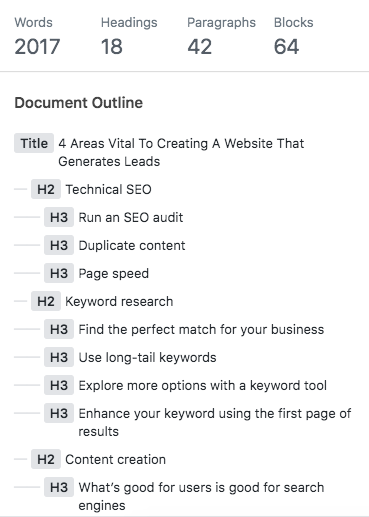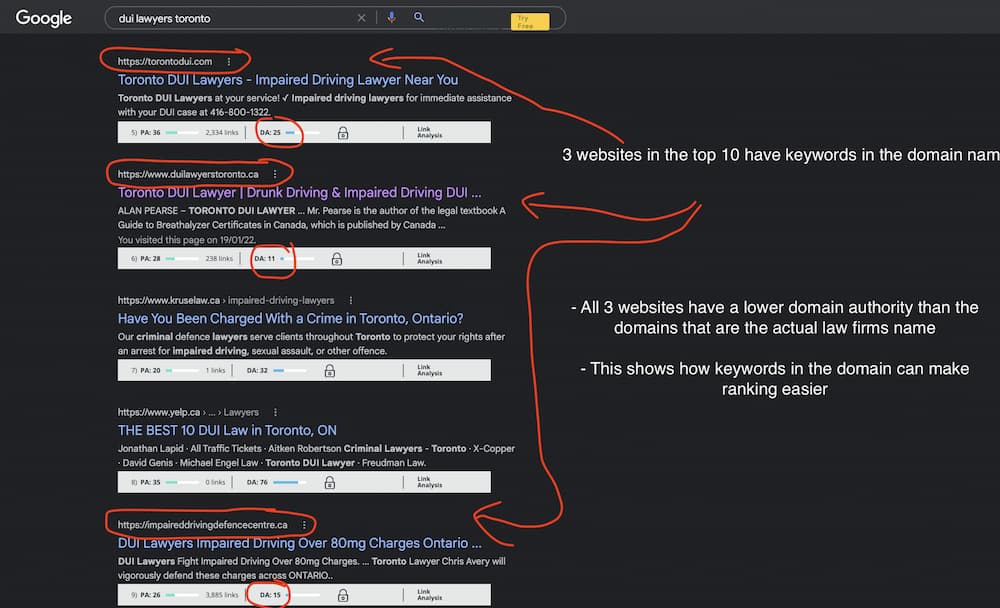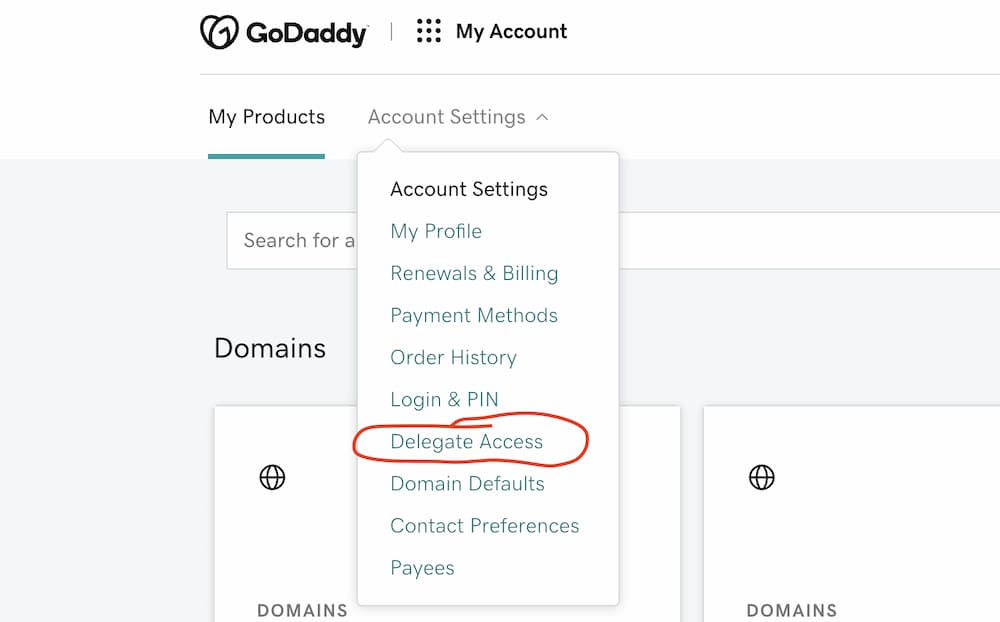Google Business Categories List and How to Choose Them for 2023
With more than 3 billion searches a day, Google needs to regulate them somehow so all those queries would find the right destination. What helps the search engine with a proper organization is Google’s local business categories. They have over 3000 selections to choose from the Google business categories list.
Yes, this is that tiny yet essential detail business owners and SEO specialists often forget when fighting for high ranks in Google.
Back in 2018, when Moz surveyed local search ranking factors, business categories appeared as a core element to have for ranking well in maps and the local pack. By picking up the right local business categories, you allow Google to categorize your business right for potential customers to find you. More than that, the primary category you choose for your business makes a big difference, influencing your online visibility and reputation.
With that said, you understand that Google sets a high value on local business categories. You know they can help a website rank higher in local search. But what is a local business category, exactly? And how to choose it for your business page?
Keep on reading to find this out.
What are Google’s local business categories?
“A local business category” is a term describing the type of your business at listing sites like Yelp, Google My Business, social media business pages, etc. It’s a classification used to group local businesses with similar characteristics and help search engines define when to show them based on a user’s search.
You select local business categories when creating your business page in Google My Business. If you already have the page there, you can easily edit those categories from your dashboard.

Each time you create a local business listing, you’ll need to choose how to categorize your business there. Google allows you to choose up to ten categories, but you still have to decide on a primary one. Choosing the wrong local business category can hurt your ranks in Google’s local results pack.
That’s what your business looks like in Google search when you add it to listings and assign its primary category right:

Local business category associations have been among the top-ranking factors for a long time already. Google’s guidelines encourage you to choose them carefully, ranking them as the #3 factor for local packs. When choosing categories, make sure you avoid repetitions and be as accurate as possible: the wrong categorization leads to irrelevant search results and rankings.
The problem with local business categories in Google
First, they are more than 2,000 to choose from.
Second, Google constantly changes, removes, or renames, and adds new entries to the Google business categories list. So it happens that, despite such diversity, it may not be easy for a business to find a category that would represent them best.
The best decision would be to choose as many closest categories as possible, right? Not quite. While Google guidelines allow you to choose up to 10 local business categories, they indicate that the fewer but higher specific, the better. That’s what they say:
“To keep your business information accurate and live, make sure that you:
- Use as few categories as possible to describe your overall core business from the provided list.
- Choose categories that are as specific as possible, but representative of your main business.
- Do not use categories solely as keywords or to describe attributes of your business.
- Do not use categories that pertain to other businesses that are nearby or related, such as a business physically contained within your business or an entity that contains your business.”
But here goes a controversion:
Based on those “as specific as possible” and “as few as possible,” you may think that one or two highly specific categories will allow you to rank higher. That’s not so.
Also, it seems that you can’t choose both general and specific local business categories, to avoid redundancy. For example, the first result in the rankings below didn’t use any categories with keywords but still was specific enough to appear in the search:

It seems complicated, no?
What you need to know about local business categories
When working with local business categories for better SEO content and rankings, remember the following:
- Google changes the names of categories all the time.
- It removes old categories and adds new ones.
- Categories have different names for different countries.
- The primary category gives you more ranking power.
- New categories can improve your ranking.
- It’s not true that having a few categories on your local business listing weakens your ranking.
- With more than 2,000 categories and subcategories available, they may appear differently in Google search results and your Google My Business dashboard.

The image and info are taken from Search Engine Land.
So, how to choose a primary local business category from the Google business category list to rank right and high? How many categories to add to your local business listing besides a primary one, and how to decide if they are specific enough for Google to understand? How to know when Google updates its categories list and when you need to update your categories as well? And what other business listings, besides those from Google, to consider for specifying your local business categories?
Stay with us to learn more.
How to pick a primary business category?
A primary category is vitally important: it influences your visibility in search engines for all related terms. For some, it seems obvious how to choose it: just pick what you are, right? But everything is not that simple.
Google recommends you choose a primary category that would describe your business as a whole. While it’s easy to do for businesses with a narrow focus, those with a broad focus or multi-location ones may get misplaced.
So:
- If your business is narrow-focused and single-location, just choose your specific category from the list. (Example: “divorce attorney,” “boat dealer,” “nuclear engineer,” etc.)
- If your business is single-location but broad-focused (water conditioner installation, plumbing, etc.), you need to decide what part of it to prioritize for search engines. Choose a primary category accordingly: think of where you want to grow, but make sure that your persuasive content, backlinks, and citations align with that business category as well.
- If you work with a multi-location business, choose primary categories for each so they wouldn’t compete with each other. (For locations that are close to each other, their business listings may compete in Google search if they have the same category.) The more specific category you can get for each location, the better. Also, test different options to find the best category combination that brings both shows in Google and high-quality traffic.
Depending on the business, you may want to edit a primary local business category when seasons change. For example, your coffee shop focuses on hot drinks and bakery in winter but on iced tea and lemonade in summer. Changing a primary category to suit the seasonality will yield some dividends too.
Some other points to consider:
What to do if your business is co-located with another (unrelated) business? Create a unique Google My Business page for each, and categorize them accordingly.
What to do if there’s no category for my business in Google’s category list? Choose a broader one that describes your business best. With more than 3,000 categories available, finding the right one for your business shouldn’t be that difficult.
How many categories a business should have?
First things first:
Google allows you to add up to 10 selections from the Google categories business list, but it doesn’t mean you need to use them all in the first flush of enthusiasm to cover as many related terms as possible.
Actually, some experts say that “adding a bunch of unrelated categories to your GMB listing will definitely have a negative impact on your local rankings.”

Founder of Whitespark, Darren Shaw specializes in SEO and local search ranking factors. This year, he shared the results of the experiment with Google business categories list in search listings, proving you shouldn’t add too many (unrelated!) categories to GMB:

So, as you probably understand, a primary business category matters but secondary ones are still necessary and important to your business relevance and rankings in search engines. That is why don’t limit yourself to a primary category: be as specific as possible and add 3-4 secondary categories to your local business listing card.
For example, your primary business category is “Divorce Attorney.” Then, your secondary ones may be as follows: “Lawyer,” “Law Office,” and “Family Law Attorney.”
- The #1 rules here: the more specific you are, the fewer businesses you’ll compete for customers.
- The #2 rule here: add the least number of secondary categories possible. The more you have, the weaker each of them gets in a search for businesses.
- The #3 rule here: describe a business, not its services. Example: if you have a restaurant with a bar, don’t choose “Bar” as your secondary category.
How to choose the right secondary categories
If in doubt about what local business categories to choose, try Mike Blumenthal’s Google Places Category Tool. Type your niche in the search box, choose a location, see the list of relevant categories, and pick up to four most specific to your business.

This tool provides you with the Google business categories list and Yelp’s, so you can use it when planning to add your business to both listings.
Another option to try for choosing the most appropriate secondary categories is the Google Keyword Planner. Add all the potential business categories into the tool and check those with the most local searches. If they are relevant to what you want to focus on for business promotion, use them.
Looking for your Google My Business category? Click below for the complete list!
Local business listings to try besides Google
Google My Business is not the only option to consider when working on business optimization for better SEO and visibility. With free business listings available, you may want to create a business profile there too.
Online communities, free business listing websites, and directories are many; and the more you choose, the greater your online footprint will be for customers to find you. But keep calm and resist the temptation of listing your business everywhere you can. Choose the most relevant platforms where your target audience “lives,” and add as much information about your business as possible to profiles there.
Here’s a short list of the most popular listings websites for your local business:
- Yelp. This is the third most popular review website on the web, so you might want to consider it for placing your business; especially if you work in the niche of restaurants.
- Facebook. With more than 65 million local business pages on Facebook, this social media network is still very popular among entrepreneurs and marketers. So why not consider creating a Facebook business page for better visibility and conversion?
- Instagram. Studies have it, 82% of customers search for a brand on social media before they buy. A visual representation of your business on Instagram will help you market to younger demographics too.
- Yahoo. With Google as the king of search, Yahoo still can bring you billions of potential customers every month. As well as Google, Yahoo displays local business listings in the search results, so you may want to get there as well.
- BBB. The Better Business Bureau is your choice to add a business if you work with local law firms or nonprofit organizations. So, create an account, search for your business, and (1) claim your listing if your business is already there or (2) submit a request to add your business to BBB if it’s not there.

- Bing. Bing Places for Business is where you can access your local business listings and categories.
- LinkedIn. Use this professional network to present your business as a reputable owner with relevant experience. It works best for finance-related businesses, so create your business profile there if appropriate.
- Whitepages. With over 5 billion records, this directory is a must to consider for listing your business. Their lists appear across all of their API customers’ websites, which can add tons of visibility to your page.
- Yellow Pages. Believe it or not, 60 million people still search for businesses at YP.com. So why not create your local business listing there?

Need more? Check the list of 25 free business listings websites from Womply, with short descriptions and guidelines on how to list your local business there, and choose those most relevant for your business category.
Conclusion
Correct categorization of your local business in Google has always been a top factor for high rankings. It impacts search results and your overall online presence for customers to find you and know about you. So, when building your local business listings, double-check your primary and secondary business categories there.
Business listings such as Google My Business and others have been designed to send you customers. And local business categories are your instrument to help Google classify your business right.
By choosing an accurate category, you’ll make it easier for robots to find you and show you in search results for people who need your products or services. You’ll show up on Google Maps and in the local pack. People will find you on the top review websites, and follow your business page on social media to build community and trust…
…And you’ll definitely see the positive result when checking and analyzing your backlink profile!
10 Expert Tips For Writing SEO Optimized Blog Posts
Driving traffic to your site relies heavily on the effectiveness of your content. In order for people to click on your pages in a search result, they have to rank high enough to be seen by users. Learn how to write SEO optimized blog posts to increase the traffic your site generates.
What is SEO content writing?
The difference between publishing SEO content and a typical journalist-styled article is that SEO content is created to rank in the search engines and has a call to action.
SEO content should play a specific role in your sales funnel. There should be a conversion objective for each article you publish that targets a specific keyword. That’s one advantage of having an SEO company in Toronto in your corner to help with content creation.
For example, if you’re explaining SEO to a beginner, they may not be ready to jump into a regular monthly investment after just learning about what SEO is for the first time.
The call to action from an explainer article would be to ask the visitor to read an article that is positioned deeper in the sales funnel.
For instance, an article on The 10 Greatest Benefits of SEO would bring that reader another step closer to wanting to invest in SEO after reading the positive effect it has on a website and ultimately a business.
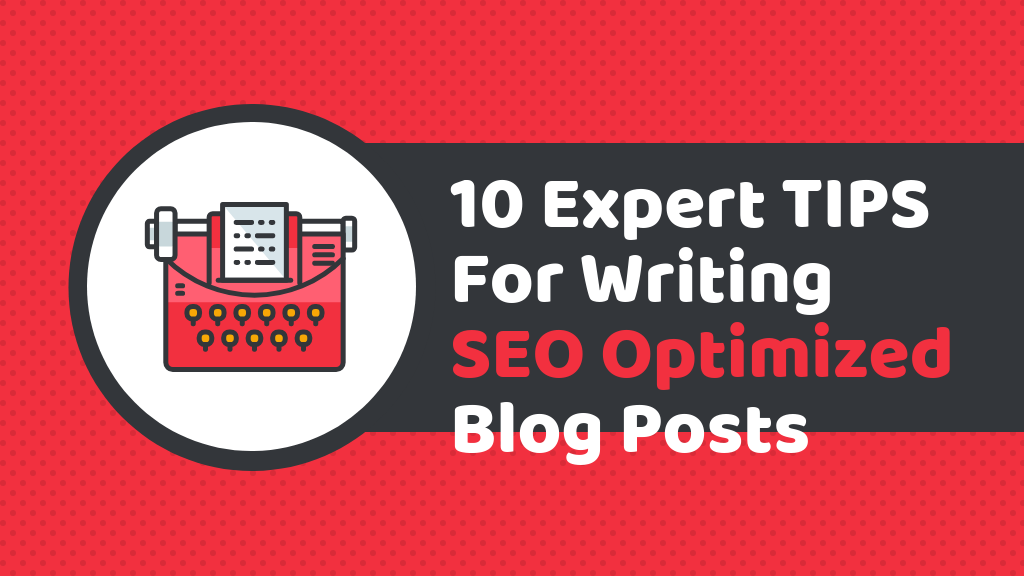
Here are 10 expert tips for writing SEO optimized blog posts that rank well and convert readers with a call to action.
- Reverse roles with your audience
- Use Google to suggest keywords
- Analyze search term metrics
- Visit sites where your audience hangs out
- Create a scannable outline
- Write at a 9th-grade reading level
- Use the inverted pyramid style of writing
- Optimize blog posts for a target keyword
- Leave a call to action
- Drive traffic to newly published pages
Reverse roles with your audience
Every great article begins with extensive keyword research. The first step to hashing out an outline is to think of the needs of your audience and what they want to read about.
Brainstorm the search terms that your audience would type into a search.
When you have a few good keywords, you will want to dive deeper into the related topics of that keyword to create depth in your content.
You can use your head for this one as well, but what will help create a more detailed strategy will be the use of a few tools.
Use Google to suggest keywords
Based on the results of your list, type them into Google and take a look at a number of different places on the page such as:
Google autosuggest;
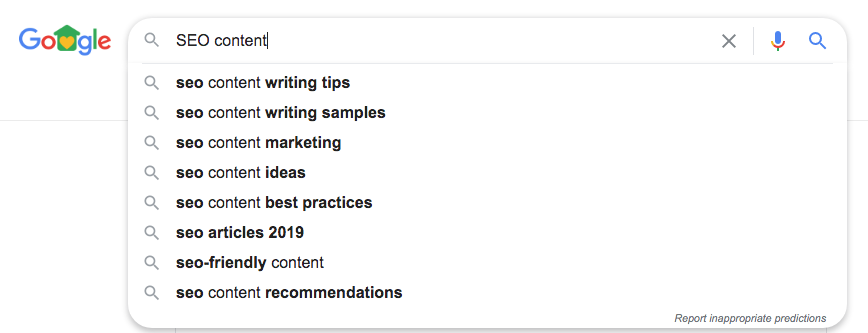
the people also ask box;
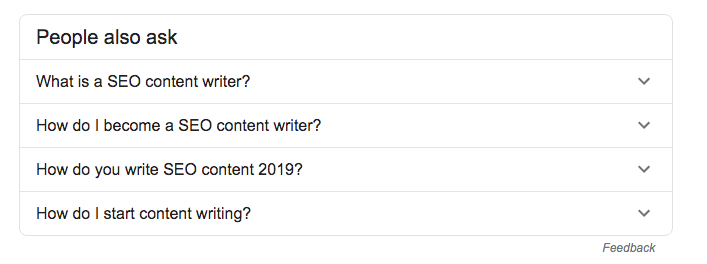
the featured snippet;
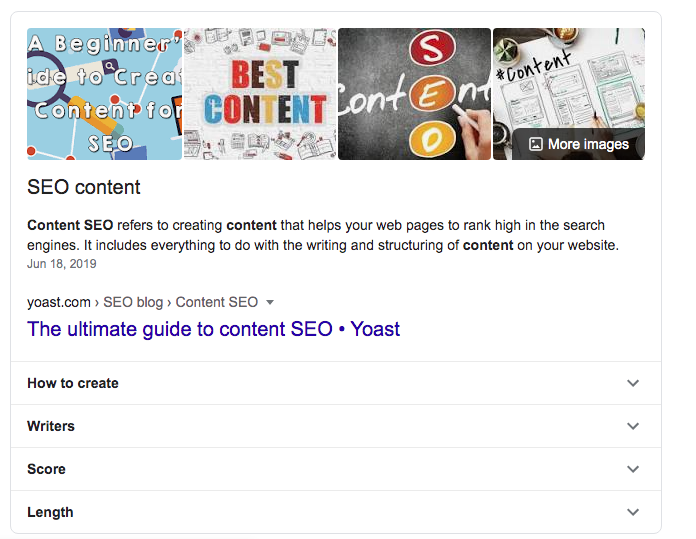
and the related searches box at the bottom of the page.
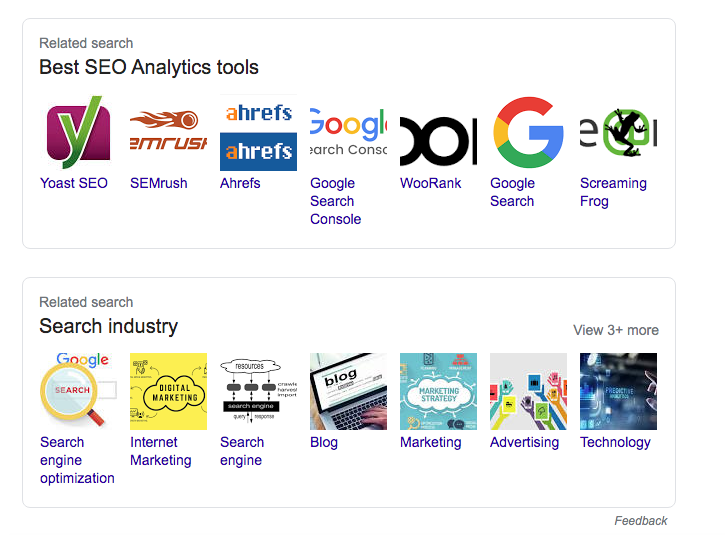
The words and phrases you find in all of these parts of the SERP are popular search terms that are repeatedly searched on Google.
Add the most appropriate results to your list.
If it’s necessary you can go a few levels deeper by typing in the new results in a search and see what different terms are generated.
Analyze search term metrics
As a precursor to writing SEO-optimized blog posts, it’s worthwhile to run a keyword report to get an idea of the competition, traffic and some keyword suggestions.
There are dozens of keyword tools available to choose from but the most popular publicly available would be Moz or SEMRush.

Make sure your keyword has a minimum level of search traffic that matches your overall strategy. You don’t want to target a keyword that gets zero searches a month.
Take note of other search terms suggestions that would fit nicely in your article.
Choose a few terms to target that are essentially variations of your target keyword.
Make it a point to use them in your content and subtitles to contribute to optimizing your page.
Visit sites where your audience hangs out
Part of a good research strategy is to find niche forums, social media groups and places your audience hangs out to discuss your keyword topic.
Quora gets a lot of traffic on a monthly basis and by scanning through questions you can get an idea of the most commonly asked questions and the terminology people are using while discussing your topic.
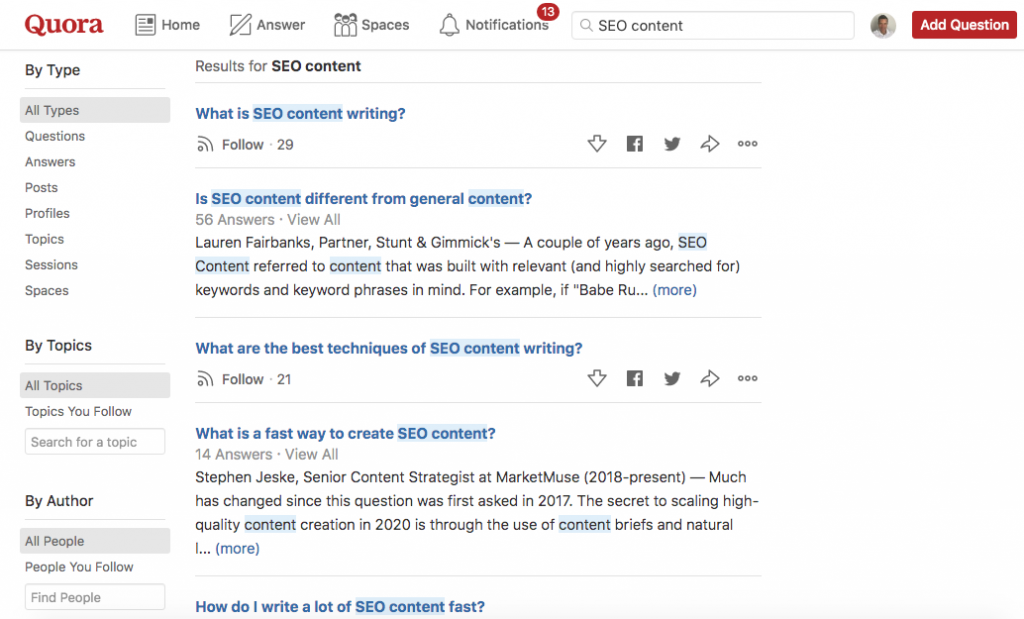
One of the biggest groups for finding a lot of relevant Q & A’s is Reddit. Simply type your keyword in Reddit to get a list of the discussion groups you can join.
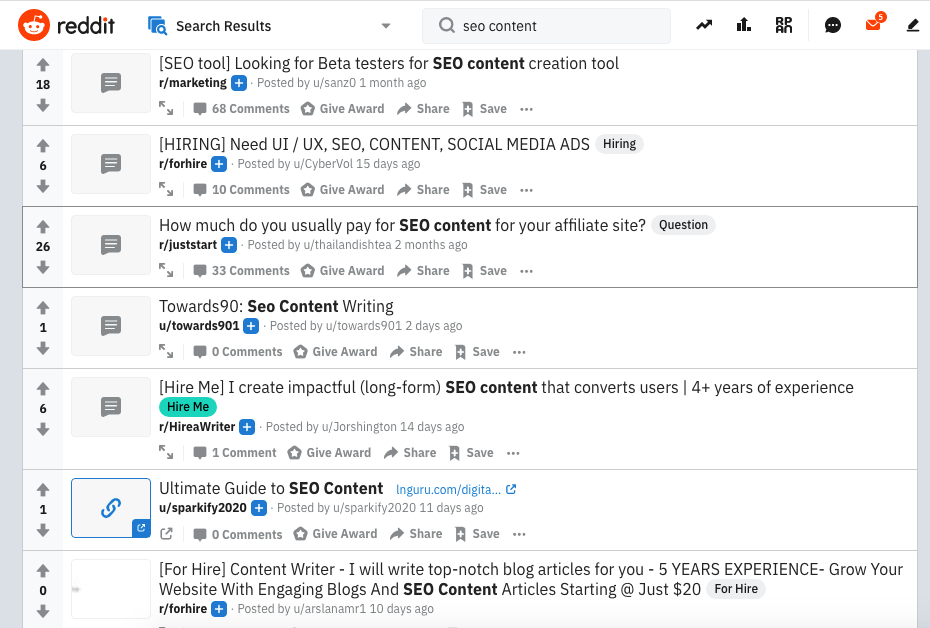
The culture here typically has a low tolerance for self-promotion so keep that in mind if you’re engaging in any discussions.
The goal is to gather as much information about your topic, what’s trending and what people are most commonly talking about.
Create a “scannable” outline
Most people who read articles online will scan through the article to see if they are even interested in the content on the page.
Create an outline consisting of subtitles to serve as the skeleton of your article.
The outline should summarize the story of your writing with as much descriptive detail as possible.
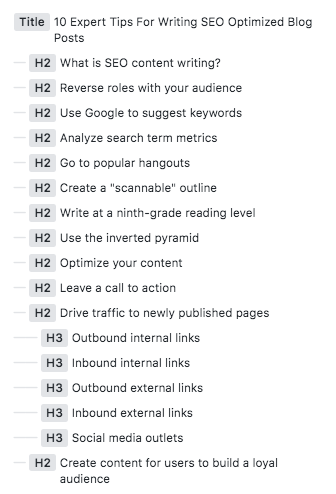
A solid outline creates an easy-to-follow guide for writing your article. Each segment is already laid out so you merely are filling in the blanks between your subtitles.
Write at a 9th-grade reading level
Write in a conversational tone that is easily understood by readers of all ages.
Approximately 50% of the US population reads at a basic or below basic level. Make your content extremely easy to understand by avoiding technical jargon and complicated words.
By making your content more difficult to read you are essentially losing half of your readers.
You can use the Fleishman score to determine how easy to read your article actually is. The Yoast plugin offers this feature.

Use the inverted pyramid style of writing
When journalists write they use a style of writing that is known as the inverted pyramid. This style of writing gives readers what they need to know at the beginning of the article and what is nice to know in the latter part of the article. This is a sweet little undervalued pearl of wisdom found within the many online marketing tactics you need to employ.

This may sound counterintuitive to those who appreciate a nice build-up. The logic behind it is that people are impatient and if you want to rope them in immediately, give them what they need to know regarding their query.
Be the last destination in their search. If they are interested in secondary details, history and other useful facts you have added, they will read on.
This style of writing insures you don’t lose your visitor to another site.
Optimize blog posts for a target keyword
It can be argued that if you’ve explained your topic extremely well that Google will automatically understand what keywords best represent your article.
However, the strategic placement of keywords will emphasize the target keyword in which your article should rank and improve your on-page SEO.
- Make sure you include your keyword in your title, URL and make sure it occurs at least a few times within your content.
- Use your keyword within the first paragraph (or 100 words).
- Enhance your optimization by adding the keyword to the image alt tags.
- Include variations of your keyword in your subtitles and text.
Leave a call to action
Readers need to be told what to do upon completing an article. What may seem obvious to you may not be as obvious to someone who is visiting your site for the first time.
Your call to action should move your reader further along the sales funnel. If it’s a new visitors reading a basic introductory article about your business, recommend another article on your site that builds more awareness of the benefits of your product or service.
If it’s an advanced article, leave a link to a service page or contact page to set up an appointment or phone call.
Leave a call to action based on what stage of the funnel your article represents.
Drive traffic to newly published pages
Even the best content in the world needs a little help in being found. You can give your pages the help it needs by driving traffic through an internal and external linking strategy as well as all social media outlets available.
Outbound internal links
Good on-page SEO means incorporating a few internal links. Include outbound links to related content. Link to some articles you’ve previously written to enhance the reader’s understanding of your topic.
Inbound internal links
Search engines rely on internal links (and your sitemap) to find new content. To get your page indexed quickly, add a few links from related articles you’ve previously published. Those inbound links will allow search bots to find your new content.
Internal links also bring readers to your newly published page, which promotes a higher click-through rate within your website.
Outbound external links
It’s considered best practice to reference authority sites from within your SEO-optimized blog posts. It adds credibility to your pages and shows Google that your page is truly serving your user’s needs.
Although it may be an SEO tactic, choose your outbound links wisely to send visitors to quality sites that will indeed enhance their user experience.
Inbound external links
Backlinks are a major consideration when it comes to ranking. Choose the most appropriate backlinking strategy that suits your goal.
If you’re attempting to rank locally you may need to lean heavily on the local link building tactics to create the most relevance for your page.
Social media outlets
Always post your content to every social media profile you’ve created. Posting over a long period of time builds an audience that provides a quick solution for getting your pages noticed and your content read.
Drive traffic to your page by leaving a call to action on every post that links to your site. Don’t forget to ask people to share with their network to get your content in front of as many eyes as possible.
Create content for users to build a loyal audience
Many mistake the purpose of SEO optimized blog posts as content that is created solely for ranking purposes.
This may have been true in a time when Google was less capable of determining the value your content holds for readers.
Create your content for users and not search engines.
The more you hold the attention of a reader and satisfy their search intent, the better your page will perform.
There is a close correlation with the quality of content and a first-page ranking. The biggest ranking factor is typically seen as the ability to satisfy user intent.
Make it your priority to write content that specifically tackles a specific search query from a user.
Combine the technical aspects of writing SEO content with a focused strategy to satisfy search intent and enjoy the fruits of a first-page ranking.
Related reading:
Digital Ducats Named “Major Player” as SEO Freelancer
Well, it’s not a huge surprise but it is quite pleasant to see reports come out like this. According to “The Business Research Company” Digital Ducats inc. (That’s us) is among the top global SEO freelancer companies. This wonderful mention was after a study was conducted that included 8 other countries.
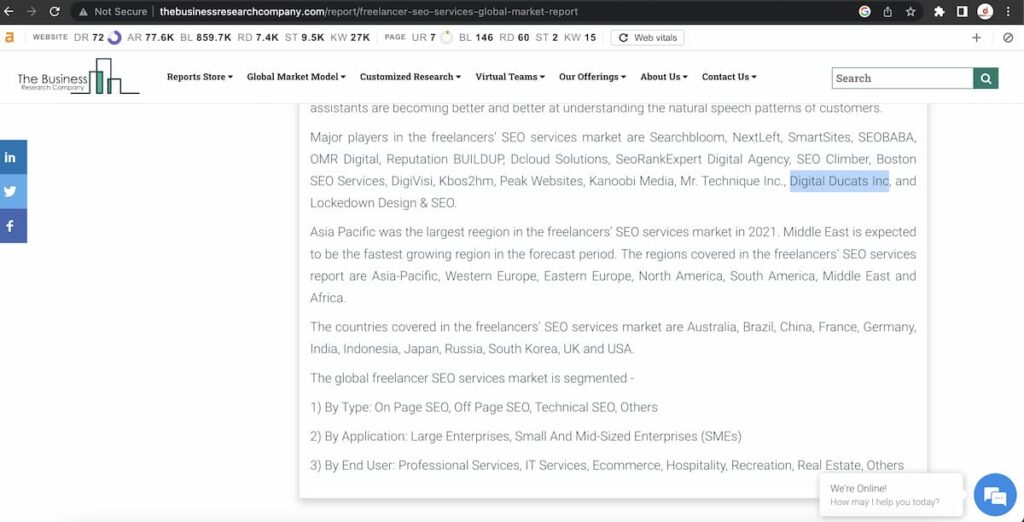
While this may seem like a lucky shot, or perhaps a fluke in the minds of all haters, this article was posted after another of its kind was published in February 2022 by the Report Linker! The same was noted in both reports. Digital Ducats Inc is the BEST SEO COMPANY IN THE WORLD!
Ok, no, they didn’t say that.
But we are considered among the best Global Freelancer SEOs in the world. When I say “we” I really mean “Me” but I do have a team to thank as well that helps me with my day-to-day operations.
Here is the article published earlier this year in February 2022:
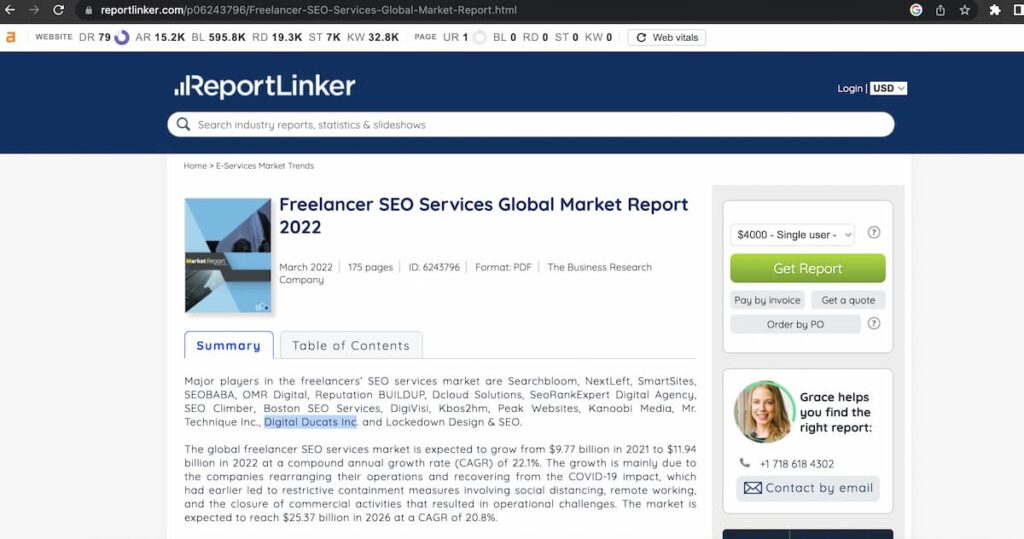
Well, I guess it wasn’t a fluke?!
Does anyone want to hear about our services for small to medium-sized businesses??!!
Secure the future of your small-medium business
Right now, Digital Ducats Inc. is in the best shape it’s been since its inception. We have a small team of dedicated writers and link builders that are suited to every industry. With Christian Carere at the helm, Digital Ducats Inc. has been able to forge the path to the first page of Google for all clients.
Local businesses love us
We have to say that our specialty lies in local SEO for businesses. It’s our bread and butter. We seem to make the best impressions on business owners from the jump in traffic, leads and sales within their first SEO campaign.
Call today or send us a message. We don’t mind giving you the guidance you need-even if you choose to work with another provider.
Until then, Best of luck!
Pillar Page Best Practices For Structuring Content
Publishing content regularly can result in your blog resembling a scattered array of articles that don’t work together as themed content. One advantage you can create as a publisher is defining themes within your content by organizing them in topic clusters. As a precursor to creating an effective topic cluster, use the pillar page best practices outlined in this article.
What’s a pillar page?
A pillar page represents a major keyword topic on your website that can be broken down into smaller subtopics. This page would briefly summarize the subtopics, but not go into great detail about them. Instead, it would link to narrowly focused articles that target long-tail phrases and in turn link back to the pillar page.

The interlinking structure formed by establishing a pillar page binds your major keyword topic. Since every smaller article points to the pillar it becomes the central hub for the topic, which enhances the page’s authority and ranking ability.
This internal linking strategy raises the profile of the pillar page to demonstrate the importance of its content as it relates to your website. This page represents a central idea being supported by a number of different articles to create depth and expertise in the subject.

There’s no limit to how many pillar pages you create on your website. For every major topic, create a pillar page to create the main hub for how the information on your site is organized.
What are the benefits of using a pillar page?
This type of structure organizes your content for both users and search engines. The interlinking structure guides and encourages users to read more related articles on the website. This leads to higher click-through rates and extends the average length of time a user spends on your website.
An increase in user engagement translates to stronger ranking signals, which results in more traffic through improved search visibility.
Pillar pages tend to rank for multiple keywords and phrases because of the breadth of content that is incorporated. This gives publishers a lot of opportunities to target featured snippets and win positions in the People Also Ask box.
It also allows for the opportunity to target long-tail keywords using the clustered content as opposed to trying to target those keywords within one pillar page.
The traffic that is driven by the clustered content is a good match to your content since the visitors enter your site through article ranking for long-tail search phrases.
The stronger your cluster content, the stronger your pillar page becomes in terms of ranking ability. It’s similar to a tree growing taller because of a strong root system. With more cluster content that ranks and drives relevant traffic to your pillar page, the more your pillar grows in stature and authority.
Tips for creating a pillar page
There’s no single way to create pillar pages and for every website, it might be different. If there’s already an extensive amount of content on your site, the process will be different than if you’re publishing fresh brand new content.
Some publishers recommend writing your clustered content first so that you know exactly how brief to be in your pillar content. There are others who prefer to write the pillar content first and create cluster content afterward.
Whichever way you go, here are some universal tips, tactics and strategies, and pillar page best practices that will help you along the way to creating well-defined topic clusters that satisfy user intent.
Select your target keywords
Every website needs a strong keyword strategy. There’s simply no way around it. In order to have a clear idea of how to create an effective pillar page, you’ll need to do some keyword research to clarify the terms that your page will target.
Start with the most obvious terms
Almost every keyword strategy begins with a logical list of topics and subtopics that are relevant to your business. Create a list of terms that summarize the most important aspects of your business.
If you’re a digital marketing company, one of your pillars should be about lead generation. Write down every aspect of lead generation to start your list of clustered content. Examples of subtopics would be email marketing, call to action, content strategy, keyword strategy, etc.
Fine-tune your selections
Once you’ve got a basic list you can then add to it using keyword software and fine-tune your selection based on competition, volume, and the value each word represents to your business.
Perform a competitive analysis
You can’t outperform the competition without knowing what exactly they’re doing to rank on the first page of Google. Perform a thorough competitive analysis to find common characteristics of the top-ranking pages.
A content gap analysis will indicate the content your page is missing by identifying what keywords the competing pages are also rankings for to include those keywords in your strategy as well.
Determine the level of detail required to rank
Figure out what the average word count is for the top 10 ranking pages. The average length of a page in the top 10 positions for your keyword indicates the level of detail required to be competitive.
Keep in mind that it isn’t the word count that makes the page competitive but rather the topics that are being covered within the page. There may be room to further break down some of the subtopics you’ve established into several subtopics.
Create content that meets and exceeds the value a user receives from the top 10 ranking pages to make sure you earn the first-page position.
Address each stage of the buyer journey
The pillar page is the central hub of a major keyword topic, so it should naturally be assumed that this page should have the ability to convert visitors into clients. To do this, you should address each stage of the buyer journey to guide your visitors from wherever they are, to making a purchase.
Awareness
Create a stronger awareness of your product or service by incorporating basic information about your keyword topic. Start your pillar page with definitions of your keyword topic so that visitors have a clear understanding of what the page is about.
Consideration
List the benefits and practical applications associated with your product service or major keyword topic. You can always link out to more detailed articles when you touch on a topic that deserves more attention and can be broken down with more detailed explanations.
Decision
Bring the visitor to the conclusion that your company offers the best solutions for what they need. Using comparisons, case studies and testimonials can help influence your visitor into a favorable purchase decision.
Optimize your content
Take advantage of the opportunity to appear in SERP features-more specifically the People Also Ask box and featured snippet. You’ll need to be aware of the questions that appear in these features in order to know how to optimize correctly.
Analyze the SERP by clicking through the question in the PAA box and copying every question that is relevant to your keyword topic. Repeat the process for related terms that your page could also rank to get more options and ideas for how to structure your headings.
It also helps to have a list of secondary keywords to use in addition to your primary keyword targets. Having a list of optimized search terms can influence the headings you use within your content.
Link to all relevant content within your topic cluster
In order to bind your topic cluster together and identify your page as a pillar of your website, you need to build internal links. Your pillar page only becomes your pillar when it’s obvious that there are multiple pages within a cluster that are linking back to it.
Link to every article within your topic cluster and make sure they link back to your pillar. Pillar pages have the most link equity and will increase in authority with more cluster content linking to them.
Be sure to link your cluster content together to emphasize the relationship of the articles within your cluster. This is not only beneficial from a technical standpoint but also enhances the user experience.
Give users the opportunity to read related content by linking to articles that move them through the buyer journey. Keep them learning about your business and how it can help them solve the problems that are commonly faced by those looking for your product or service.
Use call-to-action banners
The purpose of creating content is to educate your audience into making a purchase decision with your company. Make sure you give them plenty of opportunities to make a call, fill out a form, or complete the objective conversion goal you’ve created for your website.
Use a CTA banner throughout your pillar page wherever it makes sense. Definitely leave a call to action at the end of your pillar page to encourage more goal conversions.
Example of how to create a pillar page in a topic cluster
Create options for keyword topics by listing the major keywords of your website. Each of these keywords will act as an idea bucket which you will fill with terms that belong under your main keyword topic.
For example, let’s say your website is about home renovations. One of your pillar pages would target the keyword kitchen renovations. A potential topic cluster that organizes the information related to kitchen renovations into smaller detailed articles would look like this:

Although you would mention all of these subtopics on your pillar page, you would need entire articles to go deeper into detail on each aspect of kitchen renovations in your SEO writing.
Silo your content
Keyword topic clusters can have more outer levels than just the one that surrounds the pillar page. In the kitchen renovations example, you could break down the topic kitchen countertops into deeper detail if there is a demand for that content in your product.

Repeat the pillar page creation process
Organize your content using a structure that search engines and users understand. Topic clusters are one of the top content structures for encouraging user engagement and ultimately high rankings.
Publish pillar pages to compete for competitive keywords and increase the authority your site demonstrates for that major keyword topic. You can build the level of depth and expertise your website has by continually adding to your clustered content and providing users with the solutions to commonly asked questions and problems.
Search engines prefer to display websites they trust and those that are considered to have an expert opinion. Demonstrate both of these ranking factors by implementing these pillar page best practices to create topic clusters that rank highly to drive high volumes of traffic.
Related reading: 10 Expert Tips For Writing Expert SEO Content
SEO Content Writing: How Does It Work?
SEO content writing is a term that refers to producing optimized content that appears for target keywords. The process incorporates keyword research, SERP analysis, competitive analysis, content creation, and optimization.
Publishing search-engine-optimized content gives your posts a better chance of being found in the search results. Incorporate the following steps to create articles that rise to the top of the search results:
Want to skip the steps and have an SEO professional do it for you?
Choose the keyword best suited to your needs and ability
The keyword you choose to target should present value to your website as well as be within your ranking ability. It won’t make sense to choose keywords with a low business value just for the sake of ranking your content on the first page.

Similarly, it’s a waste of time to publish content that no one will read because it’s too difficult to drive traffic to the page for its target search terms. The keywords you choose should be a blend of suitable search volume as well as within your realm of expertise to achieve a first-page position.
How do I determine if a keyword has business value?
Use the cost per click for a keyword to indicate whether other websites are making money from the traffic it drives. The logic behind this is simply that if there are people willing to pay money for every click then they are obviously making money from that traffic.
The higher the cost per click, the higher the inferred commercial value. Apart from the transactional value of the term, you should also consider the impact your content will have on its audience.
- Does your content make your visitor feel like they need your product or service?
- Does it further educate them on making a decision about a purchase?
- What stage of the buyer journey does your keyword address?
There’s more to assigning value to keywords for transactional intent. The purpose of your content can also be to create brand awareness and instill a sense of confidence in your prospective client.
The bottom line for choosing a keyword to target is that it moves your visitor closer to making a purchase decision.
Related reading: 10 Expert Tips For Writing Optimized Blog Posts
What’s an appropriate level of volume?
Adequate search volume will be different in every niche. Typically, B2B niches with high-ticket services require less volume to make a keyword profitable.
If you’re a lawyer or plastic surgeon, one client is worth thousands to your practice.
If you’re selling poop bags for dogs on your website, you’re going to need thousands of visitors in order to pay rent for the month.
Your conversion rate will determine the true value of a keyword and unfortunately, without data, you will need to make an educated guess at how many people you can move into your sales funnel from the total volume of monthly searches.
Gauge the competition
When you’re looking at potential keywords to target, filter out options based on the strength of the competing pages. You can get a good sense of how difficult your keyword will be to rank by looking at the domain authority of the top-ranking pages.
Unless you’re planning years into the future, eliminate keywords where your domain authority is dwarfed by every domain in the top 10 results. If you own an eCommerce website, you may be competing with retail giants like Amazon, Walmart and other high authority websites. In order to outrank those sites, it will take an enormous amount of time and resources.
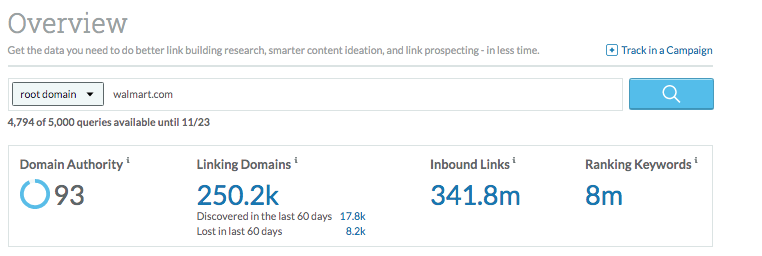
Look for openings in the SERP where websites with a similar domain authority are ranking. Keep in mind that Google ranks pages, not websites so you have the option of building links to your page to improve the page authority. That’s how you make up the difference in domain authority.
Choose your keyword based on a blend of factors
It’s rare to find a keyword that has low competition, with high volume and converts extremely well. They do exist but in most cases, you have to concede come qualities for others. Make your final decision on your keyword target by considering each of these factors and how they fit into your overall keyword strategy.
Establish search intent
One of the most important criteria for ranking highly in the SERPs is that your content accurately satisfies search intent. Identify and publish the content type and format that is best suited for users searching your keyword.
Establish what’s working to rank in the top positions by scanning the top 10 page titles on the SERP. The headlines can usually provide a strong indication of the content type that users are enjoying best.
When there’s a predominant type of content that appears in the search results, it’s an indication of what will work best to satisfy search intent. Identify which content type is the most dominant within the 10 organic search listings and plan on duplicating the same content type.
Analyze the top-ranking pages
In order to outrank the competition, you need to understand what is currently working to rank on the first page. You can’t make a “superior” piece of content without understanding what made it rank on the first page.
Analyze the top-ranking pages and determine what topics they cover and how deep into detail they go into. You can get a good idea of the outline a page has by scanning its subtitles.
Most articles will have the main points of a page highlighted by using headlines for each segment of their content. You can write them down to compare articles, or even cut and paste the content into your own CMS and see a detailed breakdown of topics. WordPress does an excellent job of summarizing the content you create on its HTML editor:
Take note of the internal and external links that they’ve used within their content as they may be valuable hints for optimization. There are some guides that rank extremely high, and the majority of their pages are external links to the various chapters of the topic.
When search engines crawl your page they will follow the links that you’ve built. If those pages are excellent resources for your topic that link will help to build the relevance of your page for satisfying search intent.
Publish 10X content
Once you’ve determined what the competition has published, aim to create content that is 10 times better than anything on the SERP. Make sure your article completely blows away the competition in every category. Provide more information and better multimedia with the intention of improving the user experience to a level that no other page can compete with.
How do I create 10X content?
After analyzing content on the top-ranking pages you should have an accurate idea of the topics that are covered and the level of depth that they’ve achieved. Your findings alone can be applied to, at the very least, provide a similar version.
Where you excel is to look at what these pages don’t have and including it in your content. If you’re pulling the best from every page you should already have a much better version of content when you put it all together.
Add depth of coverage
Keep adding to your findings by taking clues from the SERP. Use the questions in the PAA box to create more depth by answering commonly asked questions related to your keyword. The PAA box is infinite so if you continue to click on questions-more will continue to populate the box.
Add a completely new segment to your own content to boost the depth of coverage. The goal here is to provide a better solution to search intent, so keep your user in mind when you’re selecting questions that pertain to the topic you’re targeting.
Add new multimedia
Create a more enjoyable user experience by adding new multimedia to your content. Whatever the competition has used, don’t just one-up them, aim to outperform them to the point of embarrassment.
Make sure you have more images that explain more points. If the ranking page has five images, give yours at least 10. Provide a visual example for every subtopic that warrants a visual explanation. This will make your content easier to understand and digest.
Is there a video on any of the ranking pages? Make a video for users who prefer to watch and listen rather than read. Your content will appeal more to that specific segment of your audience that prefers video.
Be innovative and embed a slideshow. This can give your content a feature that isn’t as common, which separates your page from the masses. Whether it’s a slideshow, an audio file, or a gif., use whatever you believe will create a more enjoyable user experience for your audience.
Use original research and data
The more unique your content is with original statistics and real results, the more you differentiate your brand as an innovator. Visitors will trust your company and what’s more, your page will accumulate more backlinks as an original source of data.
The amplifiers in your industry are often looking for statistics when writing about topics. If you can supply original statistics from studies and surveys you’ve completed, the value of your content goes way up.
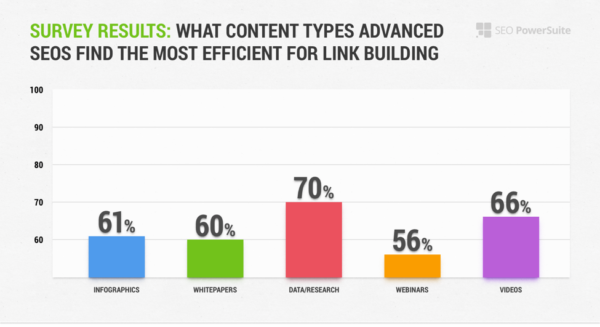
Optimize your page for performance
When you’ve finalized your draft, you will need to optimize your content to maximize the traffic you’ll receive. Not only do you want to be optimized for your target keyword, but you want to make sure your page has multiple ways to drive traffic from keyword-related searches.
Review content for the PAA box and featured snippet opportunities
The featured snippet appears for almost every question used in a search. Review your content for any opportunities where you can appear in a featured result.
If you’re analyzing keywords using a tool, you can find a list of the SERP features along with other keyword stats.
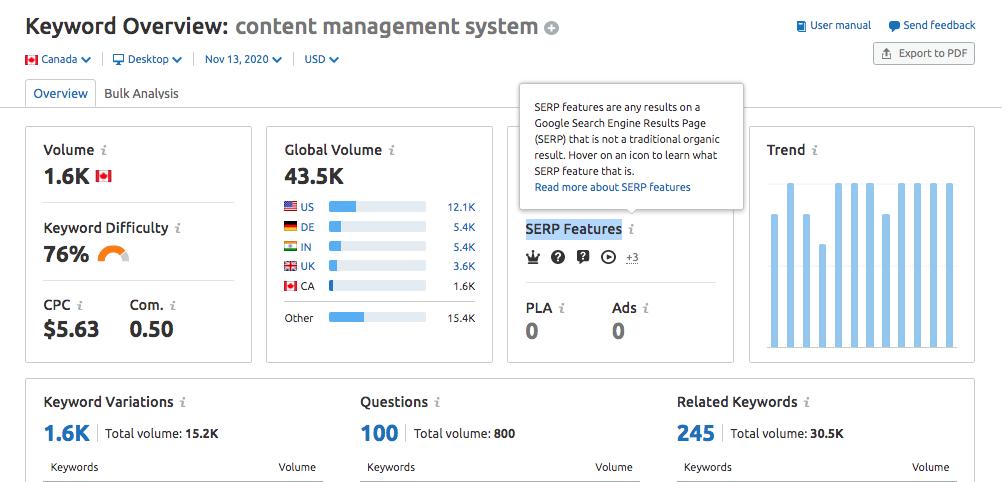
Look for questions and definitions as those are among the most common forms of snippets that appear in the SERP.
If you’ve followed the steps in this article, you may already have questions you found in the PAA box included in your content. As long you keep your answers short and succinct, you have a good chance of appearing in the feature.
Add structured data
Structured data markup enhances the optimization of your page. Schema.org has over 1300 defined entities that you can include in your page to make it easy for search engines to quickly process and establish the most important elements of your page.
Use the structured data markup helper to mark up your content. Aim for every possibility of receiving a rich result. The added search listing enhancement that rewards your page will attract more attention and ultimately more clicks and traffic to your site.
You can check here for a list of the items and the markup required to implement rich snippets in your content.
Use your target keyword in the metadata
Using your keyword in your metadata is among the oldest and most well-known forms of optimization for a reason; it has a big impact on your ranking for your target keyword.
Use your keyword in the title, image alt tags, and URL, a few times within the body of text as well as in your meta description. The meta description is the only place that search engines don’t specifically factor into your optimization-but it does impact how users see your search result.
Add secondary keywords
It’s never a bad idea to include some keyword variations a couple of times within your content. Using a keyword twice is probably enough to put it on a search engine’s radar. This adds context to your target keyword and creates more keyword options for search engines to rank your page.
When a page ranks in the number one position for a keyword, it usually ranks for hundreds of other terms and variations, according to a study by Ahrefs.

Give your page the greatest range of options when it comes to optimizing for keywords.
Finalize and publish
SEO content writing is not only a calculated approach to publishing top-notch content but is a way to publish content that drives traffic. Take the steps outlined in this article to produce content that captures the attention of your audience and is rewarded by search engines with a top ranking.
33 Ways To Drive More Traffic To Your Website
The number of ways to drive more traffic to your website is growing by the day. New ways of sharing, new websites and new developments have created a long list of options to choose from. At the end of the day, you need to do what makes sense for your business, within an acceptable time frame and within the limit of your resources.
Whether you’re doing your own SEO for your small business or are just getting acquainted with how to drive more traffic to your website, here are 33 methods to produce that long-anticipated spike in your monthly search volume.
- Publish SEO content
- Build links
- Improve CTR
- Repurpose content
- Update content
- Perform a technical audit
- Improve on-page optimization
- Guest posting
- Merge Content
- Press release
- Split testing
- Email marketing
- Page speed
- Host an event
- Website performance analysis
- Optimize for SERP features
- Use structured data markup
- Paid Ads
- Social media marketing
- Social share CTA
- Form a PIN
- Local SEO
- YouTube marketing
- Podcasts
- Image optimization
- Topical organization
- Internal linking strategy
- Use SEO software and tools
- Develop a tool or app
- Publish evergreen content
- Answer questions on forums
- Comment on high-traffic websites
- Post to content aggregators
Publish SEO content
Building a blog is undisputedly one of the most effective methods of organic traffic generation. It’s not only the volume of traffic that is so appealing, but also the fact that you can place your website in front of people who are actively looking for what your company offers.
Choose the keywords your prospective clients are most commonly using and break them down into problems and solutions you can publish content about. Publishing high-quality content that has value to your future and current clients is a surefire way for building an audience that’s responsive and engaged with your content.
As you build a library of resources on the topics that revolve around your area of expertise, your website gains authority, as does your ability to answer search intent. When it comes to choosing what websites will rank on the first page of the search results, Google and the other major search engines factor in the authority of your website compared with your competition.
A large part of this ranking signal is built through its content as well as how your audience responds. The concept of building authority can also be accelerated through link building.
Build links
The links that a website acquires validate the credibility, authority and popularity of a website. These are all ranking factors that will improve the ranking ability of your website for keyword related searches.
Not only do quality backlinks increase the authority of your website but also provide more entry points to your site so that more users can find your content. A backlink is considered to be good quality if it improves your authority or sends good referral traffic to your site.
Link building can provide a competitive edge, however, when done incorrectly can also result in some adverse changes in search visibility. Build links that improve the user experience and are in accordance with Google’s Best Practices to ensure your site an upward climb in authority, ranking and the volume of traffic it receives.
Want to learn more about how to do link building yourself? Here are 17 Backlinking Strategies to try.
Improve CTR
Did you know you can increase the traffic your site receives without even the rank of your pages changing? By attracting more clicks directly from the SERP (search engine result page) you’re able to increase the number of visitors that click on your search listing.
Entice more users to click on your pages by improving your headline. The first thing a user sees is the title of your page and if it’s a bleak and boring title it can easily go unnoticed. Use numbers, percentages or list-styled formats of your headline to maximize your CTRs directly from the SERP.
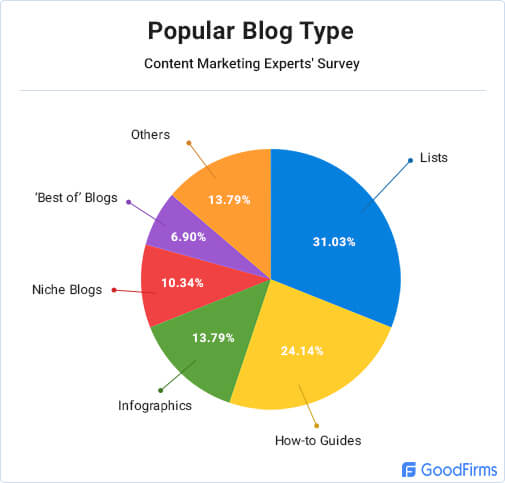
Not only does your title have this power to attract more clicks, but your meta description is also another form of advertising you can use to win over the users’ interest. Be creative and descriptive within your meta description and be sure to use your keywords within the 160 characters limit to present your case.
Repurpose Content
Make the most of the content you’ve published by creating different forms of it using multimedia. This strategy can work to improve traffic on underperforming posts that were once generating traffic and have since declined as well as posts that are popular and still generating traffic.
Everyone has a preference for how they choose to digest information, whether it be through video, audio, images or text. When you can supply different forms of the content your producing, you’re able to cater to a broader base of users and appeal to the different preferences each type of user might have.
For your stout followers and subscribers, this also provides a diverse way to present useful information in more engaging formats to keep them engaged and their interest piqued.
Update old content
New information is always being presented and we live in a fast-paced society where content can grow old and outdated fairly quickly. Search engines love fresh content and if you’ve got content that’s been sitting around and getting stale, an update can help revive your traffic.
If you’re in an industry that loves statistics, like the SEO world, having updated facts and stats is absolutely essential to providing value and being credible.
The competition for search visibility is also steadily increasing and it’s fairly common for websites to use content that ranks to make better versions of it on their own websites. If you’re not keeping up with the status quo in quality, your content will eventually slide right off the map.
Keep your content relevant and useful by updating periodically to see spikes in traffic.
Perform a technical Audit
This may be the most boring part of SEO, but it can also be the most important. If your website is not functioning properly, you might be giving up a lot of search visibility from a build-up of error codes or from pages that aren’t being indexed properly.
A technical audit will uncover many problems that can impact ranking. Use the search console to monitor your site on a regular basis. The first signs of trouble can usually be detected directly from the search console under the core web vitals tab.

Software such as Screaming Frog or Deepcrawl will also be helpful for identifying pages that have gone missing, that are indexed and that need attention.
Improve on-page optimization
It’s already been some time since Google has moved away from ranking by keywords and now ranks by keyword topic. This shift in how Google assesses your website has resulted in higher quality search results because top-ranking pages are optimized for the entire keyword topic as opposed to stuffing content with keywords.
As a result, if you rank #1 for your target keyword, you will also rank for a number of other keyword variations. Capitalize on the opportunity to improve your ranking by enhancing your on-page optimization for additional keywords.
By placing your keyword in the metadata of your content, you can instantly boost the on-page optimization. Look for opportunities in the title, body of content, and image alt tags. Refrain from changing the URL as this would be the equivalent of creating a brand-new page.
Be an active guest author
Although much has changed in the last year and a half, guest posting, when done correctly can be extremely beneficial for branding and traffic generation. Guest posting allows you to leverage other websites’ traffic by posting your content and linking it to your site.
The links can also improve your authority and ranking ability when they’re posted on topically relevant, high-authority websites.
Publish top-notch content to brand your company and entice users to click on your links. Be sure to include links to valuable resources that people will find useful and ideally present some business value to your company to convert visitors to clients.
Guest posting should be done with careful prospecting and in moderation unless you’re using nofollow links to your site. Google has been exceedingly vigilant in devaluing links from excessive link building by guest posting so you’ll need to strategize accordingly.
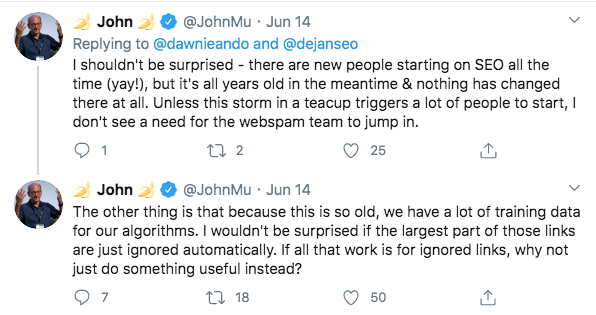
Merge Content that targets the same keyword
Google’s decision to allow the full transfer of authority through a 301 redirect makes merging content one of the options that can supercharge your traffic. Rather than have two mediocre blog posts on your website that don’t generate traffic, combine the two posts together for a bigger and better version.
Redirect the pages you delete to the new URL in order to combine the links and authority of the deleted page. This tells Google your content has moved from the detled URL to the new URL.This option should be exercised with pages that target the same keyword topic to get the full benefits of the merged content so the links pointing to those pages remain relevant.
Publish a press release
What better way to reach a broad audience and get published on some high authority websites than to release newsworthy information to the press about your company? A press release will put your content in front of a large number of journalists who regularly monitor press releases to write about something of interest to their audience.
As an old form of link building, you need to be wary of the links that are used in your press release. Most sites will only use nofollow links in your PR-which is a good thing because you don’t want Google to penalize you for unnatural link building. The bonus is when your story is syndicated on other websites, and many of those nofollow links will often become followed on other sites.
Not only do you receive referral traffic and branding but you also pick up a bunch of good backlinks that lead to an increase in search visibility and ranking.
Split testing
A/B testing can be one of the best ways to make decisions on content that provides higher conversion rates. Using software like Crazy Egg can help you conduct different spilt tests to identify what’s working best to generate more traffic to your website.
You can use split testing on your websites as well as in your email marketing campaigns.
Email marketing
This is one of the oldest forms of online marketing and still, today remains the most cost-effective method. Email marketing can get you an industry average of 3800% return on your investment and can instantly drive more traffic to your website at the click of a button.
Avoid spamming your email list with every update to your company and stick to sending fresh content according to the preferences of your audience. Every list should be segmented into each person’s preferences so you can personalize the type of content you send and get a positive response demonstrated by high CTRs to your website.
Page speed
The time it takes your pages to load can affect the number of visitors that make it your website. Studies show that for every second it takes, your site will lose visitors who become impatient and back out from your web page. The number of times a visitor lands on a page and backs out without clicking further is referred to as your bounce rate.

Improving page speed ensures more users stay on your page for more user engagement and ultimately more return visits.
Fast page speed is also considered a ranking factor. So if your website is ridiculously slow, you might be seeing some adverse effects in your ranking. In this situation, improving the speed at which your pages load will increase search visibility and drive more traffic to your website.
Host an Event
Hosting an event is a surefire way to garner more interest in your company and drive more traffic to your website. Whether it’s a live event or a webinar, posting the event on bulletin boards, on your blog and on social media will stir up a loyal and faithful audience as well as round up a few new people.
Analyze your website performance
When you want to see improvement in the performance of your website you need to be aware of the analytics it’s generating. Google provides two of the most valuable pieces of software for free to every website owner which is arguably the most comprehensive of all options.
Using Google Search Console is the equivalent of looking under the hood of your car when there’s a problem. The search console will report everything that going on in terms of functionality as well as performance. You can find errors, backlinks, impressions, clicks to your pages, penalties issued to your website and more.
Google Analytics is useful for running reports on user behaviour, traffic statistics, comparative analysis, goal conversions and customized reporting.
Analyzing the performance of your website can provide you with an accurate way of gauging the success of your current efforts and provide you insight into how to adjust and improve. Analytic reporting informs your keyword and content decisions for more successful campaigns.
Optimize for SERP features
Dozens of features appear on the first page of results in which you can optimize and capture more search visibility. The most obvious features include the featured snippet and PAA boxes.
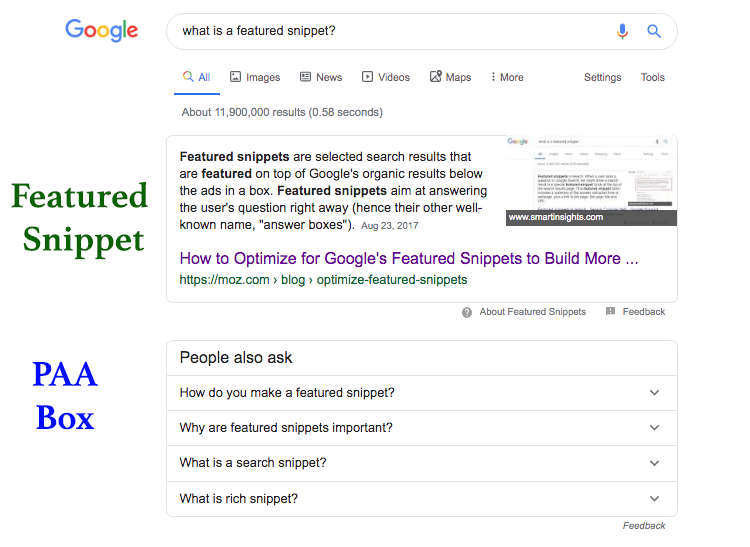
These options are the most common and therefore present more opportunity since a position can be won by optimizing existing content. The additional positions will contribute to higher click-through rates and drive more traffic to your pages.
Use structured data markup
Although implementing Schema and structured data markup does not directly affect your ranking, they can greatly affect the click-through rate your pages receive from the SERP. Using structured data markup can result in rich results that will enhance your search listing.
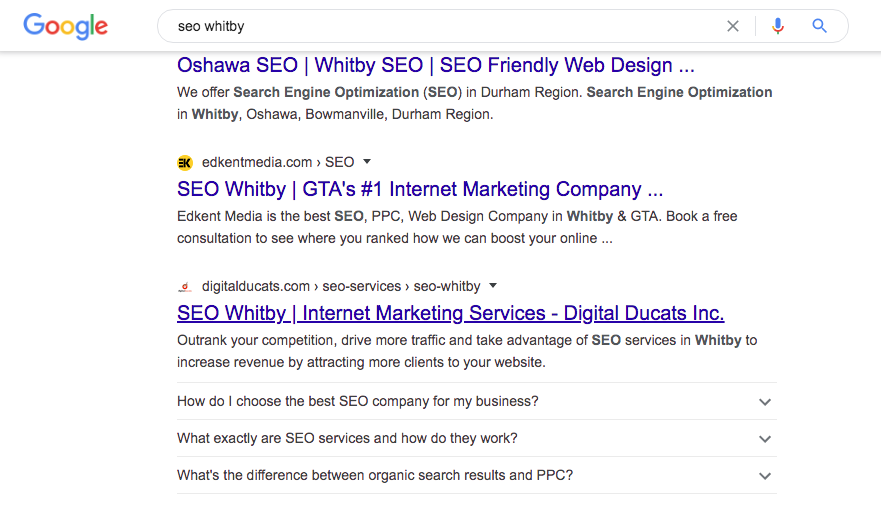
Some of the most common types of rich results you can influence are FAQ, Q & A, How-to, reviews, recipes and show times. The opportunity for rich results exists under specific conditions, one of them being that your page ranks on the first page of Google.
Invest in paid Ads
It may be obvious, but it needs to be mentioned as paid ads are an extremely viable way to drive more traffic to your website. The option for paid traffic exists on both search engines and social media.
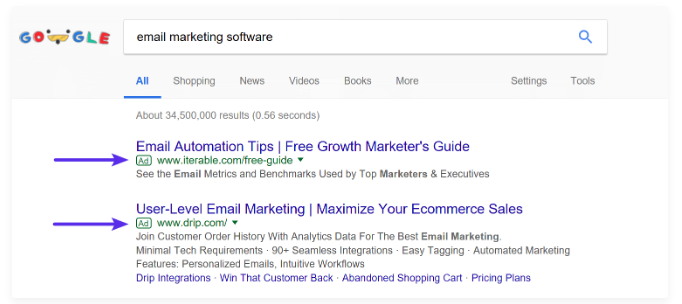
You can reduce the cost of this recurring expense by using retargeting ads where your ad continues to appear in front of those who have already visited your website. This form of advertising boosts your conversion rates since the concept is based on retargeting those who have shown interest in what your company offers.
Engage in social media marketing
Social websites are extremely valuable for increasing search visibility and getting your company in front of a larger audience. For B2C businesses social media sites like Pinterest and Instagram can supply massive sources of high converting traffic.
Did you know that 47% of “pinners” log on specifically to shop?
Effective social media marketing humanizes a business and makes them more relatable to the consumers. Avoid posting content like a robot and make sure you’re able to dedicate some time to interact with your followers.
Get social with your audience, after all, there’s a reason its called social media.
Leave more social share CTA’s
Include a call to action at the end of your posts to get more people sharing your content. People need to be told what to do in order for them to do what you want them to do. Sharing content may not be at the top of a persons list after reading something you’ve posted, but if you leave them a subtle reminder, you can improve your sharing statistics.
On facebook, if you leave CTA’s on your page you can increase your click-through rate by 285%.
The larger the audience you have, the more people will click on your site. Always leave a CTA at the end of your posts to maximize the number of people that view your content.
Form a P.I.N. (Personal Influencer Network)
Do you see many of the same names and faces in your niche? Reach out those who are in a position to amplify your content and come to an agreement about how you can support each other’s efforts.
If you’re actively guest posting it would be ideal to reach out to authors and arrange a link for link agreement. For every article you publish, you can include a link to their site and they can do the same for you.
With enough people in your P.I.N., every article you publish has an exponential impact as it becomes worth as many links as the number of people in your P.I.N. that you’ve linked out to in each article.
Establish a local SEO strategy
If you’re a brick-and-mortar business you can leverage the traffic you receive by establishing a local SEO strategy to drive traffic from your specific location. One of the best ways to rank on the first page of Google is to get your website on a Google property.
List your company in Google My Business to get your website in front of people looking for local businesses like yours. Local traffic tends to have a higher urgency for making a purchase and visitors are typically in the later stages of the buyer journey. Being in the local pack and showing up for localized search results can drive more traffic to your website and increase your bottom line significantly.
YouTube marketing
Video has exploded in popularity. It’s nothing new to business owners considering 81% use video as a marketing tool. The widespread use of video is up 18% from last year and still continues to grow.
Engagement statistics such as time spent on a page and bounce rate improve with the addition of a video. After watching branded social videos, 64% of people will make a purchase. Social shares are higher with video and 6 out of 10 consider video the preferred method of learning.
As mentioned above, some of the best ways to rank on Google is to be on Google-owned properties. The number of searches that click on a Google property has officially passed the 50% mark forming the proverbial walled garden.
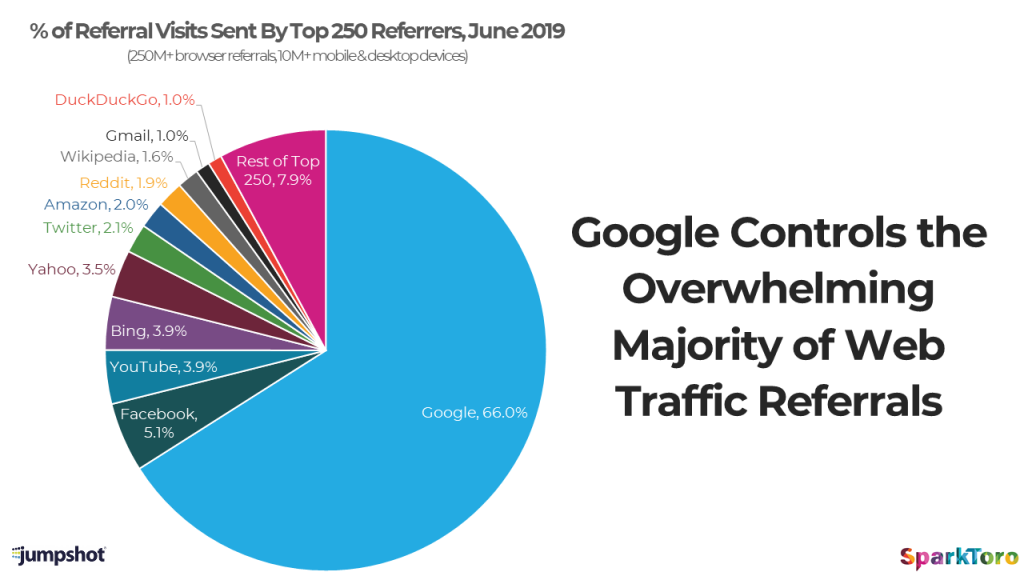
Use this to your advantage by leveraging the second most popular website in the world; YouTube.
YouTube videos account for over 90% of the videos that rank in Google search results. If you’re considering publishing a video, it wouldn’t make sense to do it anywhere else.
You don’t need to rank on Google to drive more traffic. YouTube has become its own search engine and can generate thousands of views from a successful video. Include a link to your site in the video description to refer your viewers to your website.
Participate in a podcast
Video is not the only form of media that’s been gaining popularity. Podcasts have exploded over the last few years creating more opportunities for your message to be heard.
Creating your own series requires a lot of time and resources, which can definitely pay off in the long run, however, you can also ask to be a guest on someone else’s podcast. The host of the show should have no problem linking to your site from the podcast description for some sweet referral traffic to your website.
Even if they don’t, as long as they have a decent subscribership, being featured as a guest is excellent branding and will stir up some interest from an untapped audience. Podcasts are continuing to grow which is an opportunity in itself to capitalize on getting more visitors to your website.
Optimize your Images
A potentially underrated form of driving traffic to your site is through image optimization. Be sure to optimize your images with the keyword in the filename and alt tags. Include a descriptive title and captions whenever the opportunity presents itself.
The more information you give to search engines, the more they have to associate your image in keyword-related searches.
It’s not just the keyword optimization that will get your image to the top of the results but also the number of links it has pointing to it. Create visually appealing images (with data when applicable) and ask people to give you proper attribution with a link.
Organize your content topically
Increase the search visibility of your website by organizing your content topically. If you’ve been doing your homework, you would know that Google is ranking pages based on keyword topics rather than keywords themselves. With a topical organization, you can add the depth of topic your site demonstrates and drive more traffic to your website through increased search engine rankings.

Create topic clusters to emphasize the most important keyword topics of your website. There are pillared content and clustered content that make up a topic cluster. The pillared content is the pages that represent the major keyword topics of your site. They typically cover your topic in breadth and not depth.
The clustered content is smaller more narrowly focused articles that solve specific problems or answer specific questions. For this reason, the clustered content typically targets long-tail keywords in order to rank highly and drive traffic from a highly engaged audience.

The topical organization of your site makes it clear what the major keyword topics are, which appeals to search engines. It also becomes clear for users to identify the most important topics on your website and get a sense of the depth of your expertise.
The pillar page model establishes credibility, authority, expertise and trust in its niche whic are positive ranking signals that influence more search result appearances for keyword related searches.
Internal linking strategy
The internal linking strategy you implement on your site has a direct impact on your pages performance in the search results. Internal links are also used to form topic clusters and increase the internal click-through rate so users can navigate to related pages with ease.
Use descriptive anchor text to enhance the on-page optimization for individual pages. Sometimes building more internal links to a page can improve ranking with the improved optimization.
Link to related content to guide visitors to pages that are within the same topic cluster. Clustered content always links back to the pillared content in order to build the authority of the keyword topic, improve click-through and drive more traffic to your website through increased ranking ability.
Use SEO tools and software
There are a number of tools and software that allow you to multiply the effectiveness of your efforts. Using tools can give you the insight needed to make better decisions for more calculated success.
Use analytical SEO software to find backlinks and traffic sources of your competition. Why should they keep all their juicy sources of traffic to themselves? Ahrefs, Moz and SEMRush are all versatile tools that can give you a fast and sure-fire way to ramp up your efforts on finding the best sources for quality visitors.
For instance, you can see the exact keywords make up a website’s organic traffic using SEMRush.
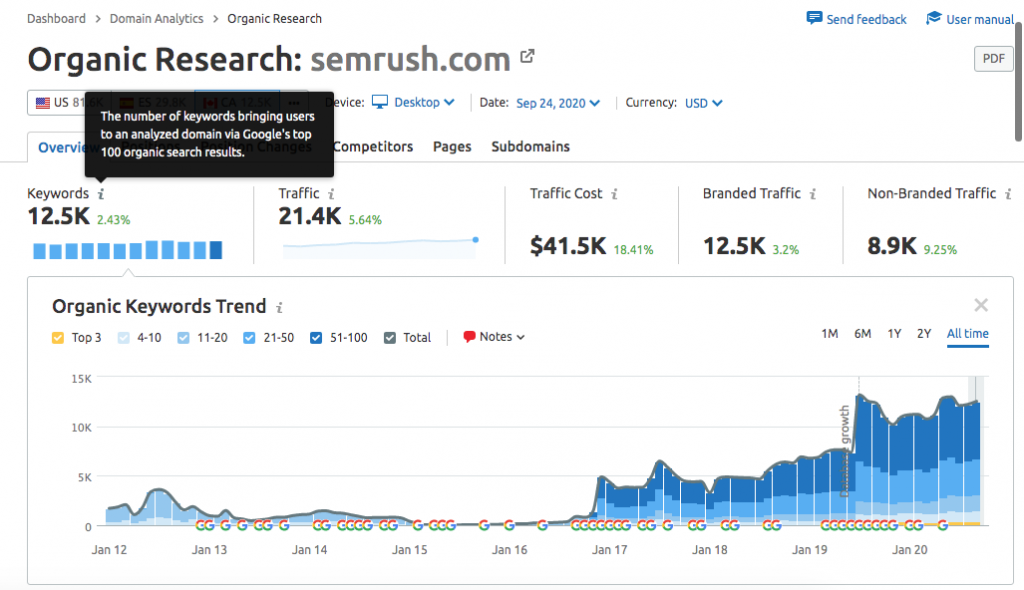
You can also discover popular content topics by using Buzzsumo. Type in the keywords of the content you want to see being shared the most so you can publish content that people have the most current interest in reading and sharing.
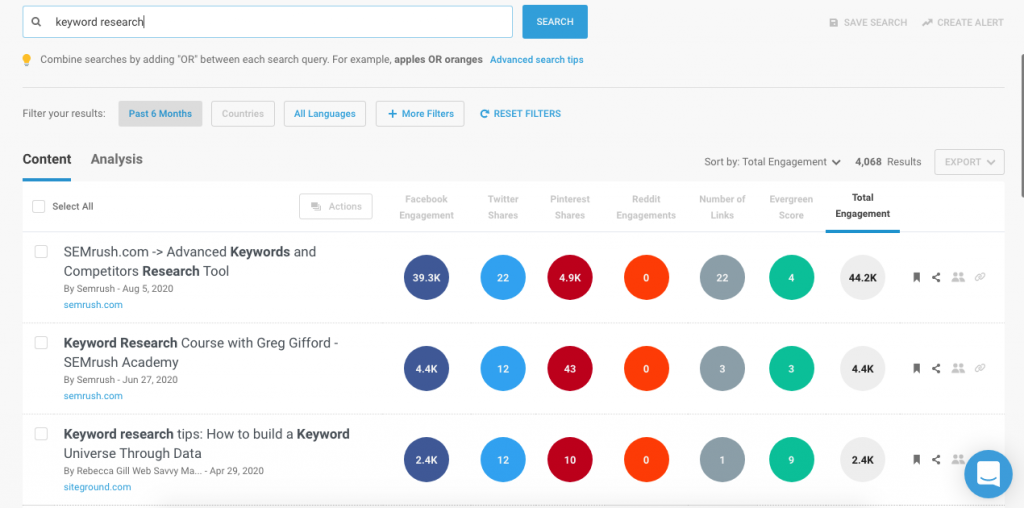
Stay on the cutting edge of your industry by making use of the tools that give you the ability to collect valuable data about your audience.
Develop a free tool or app
If you have the resources, develop a tool or app that would make life easier for your potential clients. Many businesses drive thousands of visitors to their site just to use a tool they offer. For example, Ahrefs offers users its tool called Free Backlink Checker. This page alone gets thousands of visitors from organic traffic.
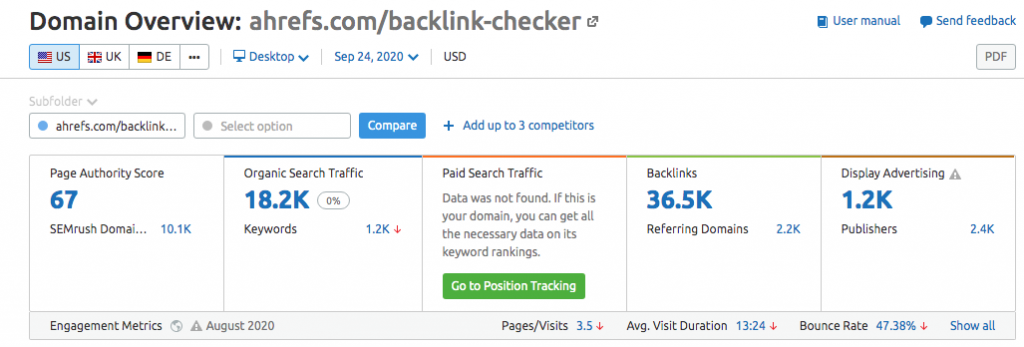
A few other examples are Ubersuggest, Answer The Public, GTMetrix and the list continues. Even Moz and SEMRush have free versions of their software to get more people familiar with their company. This may be something that is out of your scope but you should know that the potential to drive traffic to your website exists when you can offer a free tool or app.
Publish evergreen content
Rather than publishing articles on your blog that lose relevance or value overtime, publish evergreen articles that won’t lose value in the foreseeable future. News updates and current events have a short lifespan and become useless for driving traffic and acquiring backlinks. Evergreen content provides both for your website.
The bottom line for producing evergreen content is that you’re able to publish something that can be considered a link-worthy resource. This means that over the life of your post, it continues to collect backlinks, drive traffic and encourage return visits because of its inherent value as a resource.
Evergreen content typically takes the form of long-form content, such as ultimate guides, listicles, case studies, reviews, white papers, interviews, expert roundups, infographics, Q & A pages and more.
Answer questions on forums
This method of traffic generation was a widely practiced link building tactic before Google put a hex on the links that are accumulated from forums. For this reason, many people shy away from using forums for traffic regardless of the fact that it can result in streams of targeted visitors to your website.
Being able to answer people’s questions effectively and thoroughly creates trust and is a way to showcase your knowledge in your field of expertise. The trick is to answer questions on forums that are specialized to your industry as well as drive a decent amount of traffic. Quora is one question and answer site that qualifies in both categories.
Quora gets over 300 million users on its site every month and you can find people asking questions in almost every niche imaginable. You are permitted to leave links to your site within your answers and can introduce people to your business through the content you produce as answers to their questions.
Comment on high-value industry articles
If you’re not reading the biggest and the best blog sites in your industry, you should be. Not only does reading what the top websites publish to keep you current on what’s popular and trending but it also gives you a chance to send visitors from those sites to yours through some well-placed comments.
It’s true, commenting on guest posts and leaving your link has gotten a bad rep, but remember that’s because people were abusing it. There’s nothing wrong with leaving a link to your site on an insightful comment when it makes sense to do so.
Get your company and website in front of an audience that is obviously interested in the content your producing. The search visibility on some of the top sites is insane and a popular article could receive hundreds of thousands of views over time.
Leave your two cents about that article and if people like your stance, you can bet they’ll click on a link to hear some more of what you’ve got to say.
Post to content aggregators
The best thing about online strategies is that they have the ability to go viral. Submit your content to the aggregators who have the ability to get it in front of thousands of people. Many websites will syndicate the content they find which can lead to some pretty good backlinks.
What’s more, is you can get featured in Google News in related search results if your content gets a good response.
Medium has the potential to get your content in front of a huge audience because of the way their algorithm works. If your content starts getting a lot of views and social engagement, you’ll see it being shown to more people on the Medium platform.
Neil Patel claims his first big break came when an article of his was featured on Techcrunch. Leverage the most popular sites that allow you the greatest potential of going viral.
Increase traffic with the methods that are right for your business
Every industry and niche has proven methods for increasing the traffic to your website. For example, if you’re in a B2B service industry, you wouldn’t get as much from relevant traffic from an Instagram campaign as you would from publishing and ranking blog content.
There’s no right or wrong way to get people on your website but you can find the best ways by learning from those who are killing it in your field.
Analyze the efforts of your own campaigns in order to continue to learn and grow from what works best so you can scale up in those areas and continue to drive more traffic to your site on a regular basis.
How To Achieve Small Business Growth In 2022
The early stage of growing a small business is a difficult task. After you’ve started your new business, the next challenge is to keep it growing. So, how do you achieve small business growth in today’s competitive climate?
It won’t happen overnight but it’s a must to bring in new customers and thus expand your consumer base for revenue scaling.
Growth is a big goal for all small business owners. This article discusses the key factors contributing to a successful business and the strategies you can take to monitor and prepare for future development and success. It will show you the aspects of small business growth that you should pay particular attention to, as well as a method you can use as a guide to growing your own startup business.
Take a look at these proven strategies for expanding your small business.
13 Effective Ways To Grow Your Small Business
1. Improve Your Local SEO

Local SEO is essential for small company owners targeting a customer base near where the business is. If you have a website, you can use local SEO to boost your business’ earnings.
Nowadays, people are looking for more personalized internet services. Local SEO allows you to focus your marketing efforts on specific population subsets. This way, you’ll be able to take advantage of very profitable local searches for your company. In addition, local SEO gives your company a firm base on which to build additional SEO features.
It’s an excellent method to get your small company noticed in the digital world. Writing blogs with SEO keywords allows you to be on top of the search engine results. Just take Unscramblex for example, it provides SEO articles that get ranked high in Google searches. It enables companies to target local clients when they search online for their goods and services. There is a direct correlation between increased SEO services and increased local business.
2. Create An Enticing Web Design

In addition to enhancing your website’s search engine optimization and making it easier for customers to join up or make purchases, make sure your homepage looks its best. Building an eye-catching and intuitive web design by hiring web developers will attract more people to look for more content on your website.
One of the best benefits of eCommerce is that you can easily increase your brand visibility to the public, so make sure your website is well designed and easy to understand.
Several website visitors aren’t ready to purchase anything the first time they hear about your brand. Your homepage is the most likely place they’ll visit. A congested or difficult-to-navigate site can deter potential customers.
Inadequate or uninformative online content might discourage potential customers from signing up for your product. Sometimes the simplest of modifications can have a significant impact on income.
For example, this Valentine’s Day lingerie eCommerce site has a stunning platform that is both user-friendly and eye-catching for people. They generate huge sales every month because of their well-built web design.
3. Make Sure You Hire The Right People
Your company’s development trajectory can’t begin unless you choose the right people for the job and provide them with the proper training to assist you in achieving your objectives.
A resume parser can assist in populating candidate profiles, screening candidates, and searching the applicant’s database on the internet.

Maintaining your company’s development is easier if you have motivated personnel committed to its success. It’s also a good idea to delegate specific jobs so that you can concentrate on the most critical ones and build a collaborative work environment.
4. Know The Needs Of Your Customers
Identifying and satisfying your clients’ needs is critical to your successful entrepreneurship. When building your business strategy, you had to determine your target customers including their pains, needs, and concerns. This will help you address their problems and thus build customer loyalty.
To ensure customer retention, you need to ask for their honest feedback in various ways, from surveys to user reviews.

Keep an eye out for consumer complaints and utilize them as the basis for new products, internal changes, or any number of remedies.
For example, Medical Alert Buyers Guide provides free consultation on their website. It helps customers understand their products more while generating more sales for their business.
You need to keep an eye on the market and your rivals, as well as direct input from your customers. Regular market research keeps you abreast of your competitors’ activities and the impact that various economic events can have on your clients. With the use of client input, you are presented with a complete picture of prospective development options.
5. Improve Customer Relationship Management
When trying to expand your business, there are many effective ways to find new customers but make sure that you do not neglect your present consumers. Losing some clients is inevitable in business, but it shouldn’t be the direct outcome of your efforts to expand your customer base. You don’t want to add to the problem by delivering a terrible customer experience.
Quality customer service can also serve as a direct route to development. It is more likely that your present customers will post favorable reviews, suggest your company to their friends, and buy from your business again if you treat them superbly.
Here are some ways to improve customer relationships you can apply to your business:
5.1 Developing A Customer Loyalty Program
Rewarding your current consumers for their patronage is one of the primary goals of these programs. This can also help you in gaining new clients or re-engaging those who have already abandoned your company.
5.2 Do Email Marketing
An email campaign will assist keep your business at the forefront of clients’ thoughts. Moving current and future consumers through your sales funnel is also a tremendous benefit.
5.3 Respect Your Commitments
Nobody enjoys being overlooked. Make good on your promise to contact a consumer if you say you’ll do so in the future. If you don’t, your clients may get an unfavorable opinion of your company.
6. Make Use Of Social Media

It might be intimidating to get started on social networking. It’s important to note, however, that prior knowledge of social media platforms is not required to use them. It can be as essential as creating a company profile and starting to build a customer base.
SEO is crucial since it has the ability to provide well-targeted visitors to your site. When you produce and distribute high-quality content that resonates with your target audience, they become your loyal customers.
Establishing a regular posting schedule for your fans and consumers to look forward to your social media pages is important. To create a solid social media presence, you must connect with your followers regularly.
Learning more about your clients and their habits is a terrific approach. The information you obtain can be used to conduct social adverts if you feel working towards this direction. For a fraction of the cost of a full-fledged digital campaign, this method is not only simple but also a cheap approach to test promotions and measure the interest of a new consumer base.
7. Expand Your Workforce
Expanding your consumer base and increasing your revenue entails developing your workforce. Much like customer service, you must pay attention to the quality of the individuals that join your crew.
Look for people who can not just carry out the responsibilities of the position but also do some initiatives on how to improve the business. Having a team full of untrained people can lead to a bad corporate culture and choices that benefit just the company’s interests. To get fresh insights, you need a diverse group of people with varying backgrounds, experiences, opinions, and specializations.
In addition, you’ll want to concentrate on the professional growth of your present workforce while you try to hire new personnel. Show your staff how much you appreciate what they do for your company. Involve them in the goal-setting process; pay for their training and seminars. Provide them with more excellent leadership and collaboration possibilities.
Your consumers will sense your business culture from how you treat your personnel. Start by improving your internal processes, and you’ll see your firm develop.
8. Demonstrate Your Knowledge And Abilities
If you want to maintain your authority in the eyes of your clients and other firms, you must demonstrate your competence. For example, you can provide SEO-optimized informational materials, organize webinars, perform surveys, or have a Q&A session on your social media platforms. Find ways to teach others what you’ve learned, and make it seem like a no-risk way for them to benefit.
If you’re hosting an event or offering a free download, don’t forget to collect attendees’ contact details or provide a link to a dedicated promotional page. Aside from just displaying your skills, you’re also leveraging it to build a following that can one day become clients. You’ll be able to consistently do your business if you continue offering helpful information.
9. Do Sponsorships And Be Socially Responsible

It’s a fantastic approach to build your company’s reputation and demonstrate your commitment to social responsibility by giving back to the community you serve. Provide free goods and services for causes you believe in and niche-related events or arrange community events to raise awareness about why you care.
You should partner with other firms with similar philanthropic goals to have a more significant impact.
Donating and sponsoring aren’t the only options; you can also encourage ethical business practices inside your organization. Moving manufacturing to renewable energy, allowing staff paid time off to volunteer, or only buying materials from local suppliers might all be ways to improve the environment. Do the right thing and build your brand’s image around environmental and social responsibility in favor of your local community by doing the right thing.
10. Build Network

Making appropriate business partnerships and getting to know the people in your industry are essential to expanding your firm. Spend time meeting different entrepreneurs and forming connections that one day can help you grow your company.
New clients, collaborations, workers, and even investors can be found via a well-connected company. In addition, it’s a terrific opportunity to learn about new and emerging small business trends and best practices that you learn and apply to your business.
Strategic collaboration with another company will help you expand your consumer base or match your company’s development with long-term objectives. Starbucks and other big retailers like Barnes & Noble and Target are good examples of a successful strategic relationship. The arrangement allows the coffee business to expand its reach and generate more income.
With the support of an outside vendor, you may grow your company. Maintaining good vendor connections and managing business ties are essential in cooperation.
By building your solid network, you can do affiliate programs that can enhance your brand awareness in your target market with the help of other businesses. Digitarial offers affiliate marketing for B2B partnerships and referral programs.
11. Measure Progress And Make Adjustments
Whatever growth strategy you choose to expand your company, be careful to keep tabs on your progress. Creating and letting a change run without specific goals or outcomes in mind will be futile. Without them, a well-intentioned growth plan can quickly become expensive.
If you’re not getting the outcomes you want, don’t be hesitant to terminate or pivot initiatives. To find the most effective road to success, you can set up fresh iterations and execute them again. Here are the things you should measure and monitor in your business:
11.1 Number Of Followers
It is important to know if your followers are increasing or decreasing. Having a lot of followers can also entice other people to know your products, thus this will increase your sales and engagement.
11.2 Sales Every Month
If you are not getting good sales for a particular month, identify those factors and try to plan on how to prevent such things from happening again.
11.3 Number Of Engagement
Monitoring your social media engagement can help you realize what your customers want and what content they are not interested in. Identifying their wants and needs will increase your sales and loyal customers at the same time.
11.4 Reviews And Feedback From Customers
Even bad reviews will be helpful for your business’ growth. Learn what areas you should improve and take all feedback as positive for the future of your business.
Don’t stop measuring and refining even if you’ve hit the goal of your business plan. In the short term, webinars, content marketing, developing new products, and building a solid bottom line can contribute to your business’s rapid growth. Marketing courses can also give you unique and trending ideas for effectively marketing your products.
12. Find Other Income Generators
Additional revenue sources can be essential if your primary business model cannot expand sales. New products or services, alternative price schemes for different consumers or subscriptions, and even passive revenue through advertisements and sponsorships are options you can consider.
Look at each new source of revenue as an addition to your company. You’ll probably need to put together at least a basic business plan to see whether or not the new project is feasible and can be supported by your current operations. Before expanding, think about how much it will cost to start and how long it would take to break even.
Finally, be confident that your new project aligns with your company’s goals. Even if it starts as a way to supplement current activities, it can eventually need to be spun off into its entity.
13. Create A Detailed Business Plan

A business plan is essential for your small business growth since your business will experience periods of development and periods of stagnation regularly. The most important thing is to continuously look for new development possibilities and not be scared to be innovative and try them out. You should, however, keep an eye out for opportunities that might be a huge mistake. With a business plan, you would be able to point out your SWOT as well as financial forecasting plan.
Check your company strategy and predictions if you’re unclear about whether to take advantage of a growth opportunity. You can use it to see whether your idea is feasible and if your company can handle any future short-term expenditures or negative cash flow. Try using a planning tool to help you keep track of your progress and update it regularly, or you can do it manually.
How To Solve Budget Problems For Your Business
Now that we have discussed effective ways to grow your small business, what should you do if you have an insufficient budget to implement these business development strategies?
Startup business loans allow new businesses to get off the market without meeting the strict requirements of typical company loans. The running expenses of a startup may be covered by various sources, including:
- Bank loans
- Credit lines
- Equity financing
- and credit cards for small businesses
However, entrepreneurs with a poor credit history might benefit from more flexible financing options, such as those provided by friends, family, and crowdfunders.
Small firms with no prior credit history or track record may be eligible for various startup business loans. Because of this, startup loans come in various shapes and sizes, and each has its own set of eligibility rules and application procedures. Different loan amounts and periods are available depending on the lender and the loan type. On the other hand, startup business loans have fewer restrictions on who may get one than typical company loans.
Conclusion
Following all of these effective methods will definitely give your business the upper hand you need to survive and grow as a small business owner. Promoting your products, learning the wants and needs of your clients, and giving them customer service will result in more customers for your business.
When small businesses use SEO to build quick, resilient, and user-friendly websites that rank high on Google, more qualified prospective consumers will visit their sites, resulting in improved conversion rates.
Search engine users are more inclined to trust a site on the first page of search engine results pages (SERPs) than a brand that isn’t on the first page of results.
You should use SEO services as a small company owner to establish a strong online presence and outrank your competitors to get new clients and grow your business.
Digital Ducats can give you the expert SEO services and consultations that are perfect for your small business. Read our blogs to learn more about how SEO works and how to run a successful business.
Local SEO vs Global SEO: What’s the Difference?
When you design a website, you have to decide which target market you are trying to reach. There are two types of SEO that can help you achieve this: Local SEO vs. Global SEO.
A good SEO strategy is essential for any business that wants to be successful online. But what’s the difference between local SEO and global SEO? And which one is right for you?
Here’s a look at the difference between the two, and how they can help you achieve your website goals.
The Search Engine
Before we get into the difference between local and global SEO, let’s take a quick look at how search engines work.
A search engine is a tool that allows users to find websites and information on the internet. When you type a query into a search engine, it uses algorithms to find the best results for you. These algorithms are constantly changing, which is why SEO is an ongoing process.
The search engine result pages (SERPs) are made up of organic results and paid results. Organic results are the websites the search engine has determined most relevant to your query. The paid results, on the other hand, are the websites that have paid to appear in the SERPs for a specific query.
The majority of clicks go to organic results, so it’s important to focus on SEO if you want your website to be successful.
What is Global SEO?
Global SEO is the process of optimizing your website for global search results. This means that when people search for keywords related to your business, your website will appear in the search results regardless of their location.
For example, if you’re a business that sells shoes, you want to appear in the search results when someone types “shoes” into the search engine.
It doesn’t matter if they’re searching from the United States, Canada, Australia, or any other country—you want your website to be one of the first results.
To do this, you need to optimize your website for global search engines like Google, Yahoo, and Bing. This can be a challenge because you have to compete with other businesses that are also trying to rank for the same keywords.
But if you can get your website to rank high in the global search results, you’ll be able to reach a larger audience and increase your chances of getting more website visitors.
What Is Local SEO?
Local SEO is the process of optimizing your website for local search results.
If you have a brick-and-mortar business, or if you serve a specific geographic area, then local SEO is essential.
When people search for keywords related to your business, you want your website to appear in the local search results. For example, if you own a bakery in Los Angeles, and someone searches for “bakery Los Angeles,” your website will appear in the search results.
Local SEO is important for any business that wants to be visible to local customers. And it’s especially important for businesses that have a brick-and-mortar location.
If you want people to be able to find your business when they search for relevant keywords, then you need to optimize your website for local SEO.
Why are the SEO Strategies Different?

The strategies are different because the goals are different.
Local SEO is focused on getting your website to rank high in the local search results. When people search for keywords related to your business, your website will appear in the search results regardless of their location.
Global SEO is focused on getting your website to rank high in the global search results. This means that when people search for keywords related to your business, your website will appear in the search results regardless of their location.
How to Find the Local Traffic?
To find your local traffic, you need to use keyword research tools like Google AdWords Keyword Planner and Google Trends. Enter your keywords into these tools, and they will tell you how many people are searching for those keywords in your area.
You can also use these tools to find related keywords that you can target with your SEO efforts.
Once you know which keywords to target, you can start optimizing your website for local SEO.
To better understand your audience, customer behavior, and the competition in your area, you can always turn to the best big data company. That way, you can develop a comprehensive and effective local SEO strategy.
How to Optimize for Local SEO
There are a few things you can do to optimize your website for local SEO. First, make sure your website is responsive. This means that it should be viewable on all devices, including mobile phones and tablets.
Second, claim your business listing on Google My Business. This is a free listing that allows you to control how your business appears in Google’s local search results.
Third, add your location to your website. Include your city, state, and zip code on your contact page, and make sure your location is included in your website’s title tags and meta descriptions.
Fourth, create local content. This means writing blog posts about topics that are relevant to your location. For example, if you own a bakery in Los Angeles, you could write a blog post about the best bakeries in Los Angeles.
Fifth, build local links. This can be done by listing your business in online directories, or by working with other businesses in your area to create cross-promotional content.
Local SEO is an important part of any business’s SEO strategy. If you want people in your area to find your business when they search for relevant keywords, then you need to make sure your website is optimized for local SEO.
How to Optimize for Global SEO
In order to optimize your website for global search, you need to do two things: create high-quality content and build links from high-authority websites.
Content is still king when it comes to SEO, so your first step should be to create informative, well-written, and keyword-rich content. Once you have strong content on your website, you need to start building links from other websites.
Link building can be done in a number of ways, but some of the most effective methods include guest blogging, infographics, and directories.
Guest blogging is when you write a blog post for another website in your industry. This is a great way to get your name and your website in front of a new audience.
Infographics are visual representations of information. They are popular because they are easy to share and they can help you rank for multiple keywords.
Directories are online listings of businesses in a particular industry. Getting listed in directories can help you build links and improve your visibility in the search results.
Global SEO is a bit more complex than local SEO, but it is still an important part of any business’s SEO strategy. If you want people from all over the world to find your website, then you need to make sure your website is optimized for global SEO.
The Effect SEO Strategies Have on Each Other
The main difference between local SEO vs global SEO is the focus of the optimization efforts. However, the strategies are not mutually exclusive. In fact, it’s often beneficial to use both strategies together.
For example, if you want to rank high in the local search results, you need to make sure your website is responsive and that you have claimed your business listing on Google My Business.
But you also need to create local content and build local links.
Similarly, if you want to rank high in the global search results, you need to make sure your website is responsive and that you have included your location in your title tags and meta descriptions.
But you also need to create high-quality content and build links from high-authority websites. The bottom line is that both local SEO vs global SEO is important, and you should use both strategies if you want to achieve the best results.
Where to Start?

The first step is to assess your current SEO efforts. Are you focusing on local SEO or global SEO?
If you’re not sure, then take a look at your website and see if it’s optimized for both local and global search. Once you know where to focus your efforts, you can start implementing the strategies we’ve outlined above.
Depending on the size of your business and your budget, you may want to consider hiring an SEO agency to help you with your optimization efforts.
An experienced agency will be able to help you assess your current SEO strategy and make recommendations for how you can improve your results.
The type of business you own could also tell you whether you need global or local SEO.
If you have a physical location that people can visit, then you need to make sure your website is optimized for local SEO. However, if you don’t have a physical location or if your customers are located all over the world, then you need to focus on global SEO.
No matter what type of business you have, it’s important to use both local and global SEO to ensure that your website is visible in the search results.
Having a strong SEO strategy is essential for any business that wants to be successful online.
Conclusion
Local SEO vs Global SEO are two different but equally important types of SEO. Depending on your business, your goals, and your budget, you may want to focus on one or both types of SEO.
If you’re not sure where to start, take a moment to assess your current SEO efforts and see where you can improve.
Recognized as a Game Changer in the SEO Industry by Clutch
The digital marketing industry has been one of the fastest-growing industries in the world today. PPC, SMM, and SEO have been at the forefront of this digital revolution. SEO has been one of the, if not the most, popular among the bunch. The first result in search engines has been influential in today’s digital age and SEO can help you reach this coveted spot. At Digital Ducats Inc., we help businesses and companies as they try and start their own SEO journey.
Founded in 2015, Digital Ducats has been specializing in providing high-quality digital marketing and search engine optimization services to small to medium-sized businesses. Our goal is always to help our clients transform their websites into lead-generating assets. In today’s digital landscape, having a capable SEO partner can make or break your digital marketing efforts.
For more than 6 years now, our team has been working with amazing companies in different industries. We’ve managed to receive amazing awards and accolades from the industry. Today, we are looking to receive another one from Clutch!
Clutch, for those that don’t know, is an established platform in the heart of Washington, DC, committed to helping small, mid-market, and enterprise businesses identify and connect with the service providers they need to achieve their goals.
Clutch states that our company was one of the game-changers in the SEO industry in Canada! They mentioned that we were able to deliver impeccable services and solutions that helped our clients in achieving their goals. This is a huge honor for us! We couldn’t imagine ourselves being in this position without the help of our amazing team. Their passion and dedication are what led us to win this amazing award.

Of course, this award is also thanks to our amazing client and their incredible support! Here are some of the amazing feedback and reviews we’ve received from you guys throughout the years:
“They stay on their game, and they’re responsive. I like that they’ve maintained their level of customer service, even though we’ve been working with them for a while.“ John Ferrigamo, Owner of John Ferrigamo Custom Suits.
“There was a personal connection, and they cared about my business success.” Paula Loh, Owner & President of Surf’s Up! Laundry & Dry Cleaning.
Let’s turn your dreams into reality! Get in touch with our team today and let us know how we can help you.
How To Choose A Good Domain Name For Your Business
Choosing a domain name may seem like the easiest part of your journey, make no mistake, the selection and securing process are layered with pitfalls that can affect the future of your business. There is literally a list of considerations to ponder before deciding (hence the existence of this article!). Learn how to choose a good domain name for your business and you will be one step closer to experiencing success on the search engine result page.
Approximately 37% of all domains are .com but does that make it the right choice for you? Here are a few things to consider when you’re both choosing your domain and setting it up with your registrar.
Choose a name that’s easy to remember
Try to pick a name that best represents your brand but is simple to remember. It’s a great name when people can simply type it in and go directly to your website. It helps when the domain has something to do with the product or service you provide.
More often than not, a shorter domain is better.
One or two words are ideal.
Three words are acceptable.
Four words are overkill.
Using keywords vs. a brand name
Consider the SEO strategy when you’re deciding on the domain name of your website. If you’re in an intensely competitive field, you may want to avoid choosing the name of your business as the domain. Without a big budget, it may be difficult to rank your website for a keyword(s) that could literally be worth hundreds of thousands a year.
For example, to rank a lawyer’s website for the top keywords in a big city it would be advantageous to use big keywords that get thousands of searches a month. Look at the search result page for DUI lawyers Toronto.
Two of the top five results include the keyword (or partial-which works well too) within the domain name. The third domain at the bottom does not have an exact match but Google recognizes the search intent and has matched this domain to the keyword search.
Note that none of these domain names mentioned is NOT the name of their law firm.
Avoid hyphens & stop words
Stay away from using hyphens and stop words that could lead to confusion or mistakenly landing on someone else’s website. Stop words are words that separate keywords but are generally filtered out by search engines.
For example, plumbing-contractor.com is actually a pretty good domain name however, it would be better to get plumbingcontractordallas.com because
a) Plumbing is a service industry that’s limited to specific service areas (unless you’re a national franchise). and
b) You can still rank for plumbing contractor AND people won’t land on someone else’s site if they forget the hyphen.
There is SEO value in incorporating hyphens when you’re competing for a competitive keyword but it’s better to avoid it whenever possible.
Stop-words or adding letters and numbers to your domain is an SEO technique that can be useful. The problem is it doesn’t look very professional. Depending on the purpose of your site, consider whether you business is best represented by a domain like this:

Choose a top-level domain (TLD)
TLDs are the domain extensions that are widely recognized and considered at the top of the list of options. These used to be the only TLDs during the first days of the internet:
- .com
- .net
- .org
- .int
- .gov
- .edu
- .mil
Each of these TLDs represents a category that the content of the website fell under. Now there are over 1000 new extensions to choose from including country code TLDs. Here are just a few examples of what you may have seen if you’ve been shopping:
- .digital
- .agency
- .club
- .today
- .solutions
- .co
- .shop
- .biz
- .pet
- .blog
- .io
- .coffee
- .online
- .me
- .xyz
- .live
- .co
- .store
So how do you choose a good domain name for your business website? In most cases, the best option is to go with a .com since people are 3.8 times more likely to assume that the end of a domain name ends in .com.
This is good for businesses operating in the United States and who target a global audience.
If your business only provides services or products within your country, then using a ccTLD (cc=country code) is the best option. Search engines recognize ccTLDs as local businesses and will give some preference to websites in a local search result within your country.
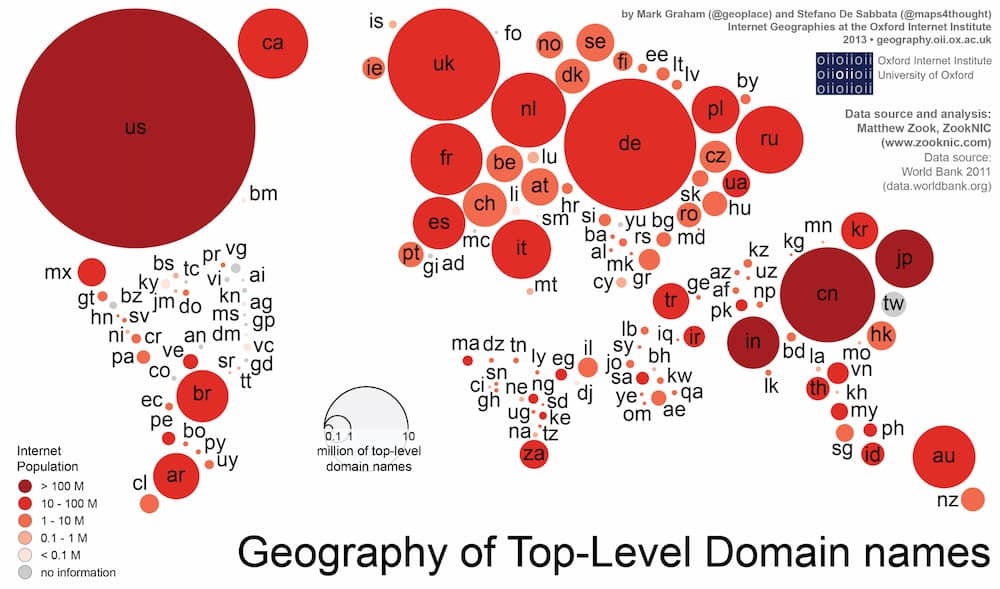
You can go outside the norm and get creative with your gTLD (g=generic) when you feel there is a good way to create a unique and memorable name. If you’re selling coffee beans, it may be advantageous in the long run to register www.beans.coffee as your domain name.
Secure your domain to avoid disaster
When you choose a good domain for your business website, you’re laying the first level of foundation for your business website. You will undoubtedly put endless hours of work (or money) into developing it. Building a business isn’t a short-term project either. Stop for a second to think of what life would be like if, after 6 years of pouring blood, sweat, and tears into your site, it suddenly disappeared from your account.
No words can describe the horror of this situation. It is a complete nightmare to live through. Believe it or not, this happens to people more times than you ever thought was possible.
Here are a few tips to make sure this never happens to you.
Switch your domain to auto-renew
Sounds simple enough right? When the time comes for your domain to renew, the payment is automatically made, and you’re all set to go. Most people lose their domain because they let it expire. Think your domain is safe now? Nope! There’s more to this story.
Enter a secondary payment method
Adding a secondary method of payment creates a failsafe for things that can go wrong. Perhaps you renewed your credit card and the number changed. Maybe your card was at the threshold and the payment didn’t go through. Whatever you think is impossible to happen can eventually find a way to happen.
Enter a secondary email address
Normally when your domain is set to renew (or expire) you get multiple email notifications that count down the days to give you time to pay. It’s not unheard of for people to switch email addresses and forget to update their address with their domain registrar.
Changing the admin@yourdomain.com address to info@yourdomain.com might be the dagger that kills your communication method between you and your registrar. If they can’t tell you your domain is expiring or your payment hasn’t gone through, you’ll lose your domain.
Always maintain ownership of your domain
Never allow an agency to purchase your domain for you. If the domain is in their account, they literally own the domain. It’s like buying a car in someone else’s name who also holds on to the pink slips. If there is a falling out and they want to hold your domain hostage, there’s not much you can do about it.
Delegate access rather than divulge login info
You can delegate access to employees and third-party companies who may need to point to nameservers, work on email accounts, or whatever. This way they can still access your account to do what they need to do but do not have the authority to transfer domains out of your account.
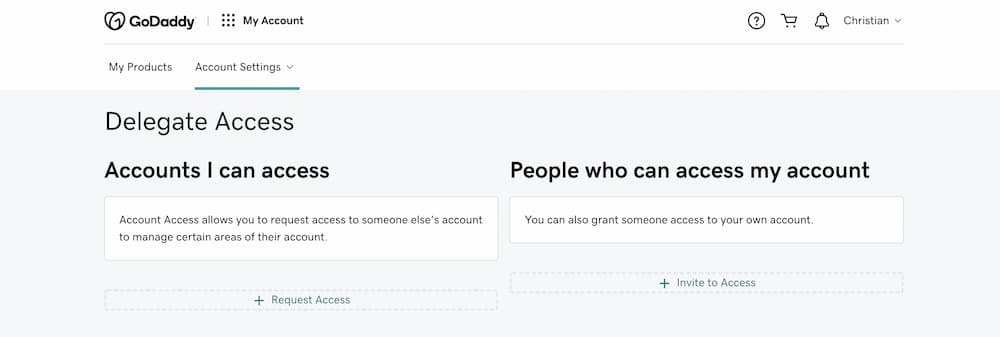
Lock your domain
You should have the option to lock your domain to prevent transfers to another registrar. It should be as simple as clicking a button or editing settings.
Enable two-step verification
Two-step verification is another way to control who has access to your registrar account. Every time someone (including yourself) tries to log in you will be prompted to enter a code. This prompt is usually sent to you via text, phone call, or email depending on your setup.
The shortcut to quick rankings
It needs to be mentioned that one of the quickest ways to achieve instant traffic and potentially high ranking in search engines is to buy a domain that has been around for a few years. One of Google’s ranking factors is trust. Aged domains are like fine wine. If they haven’t changed hands extensively, they get better with age.
That being said, this tactic is a well-known SEO tactic where we redirect the aged domain to a target domain that we want to rank higher. So you can use the domain itself (if there are no copyright infringements OR if it’s a generic name created for SEO you can use it for your own business. For example, https://seoallentx.com would be the perfect domain name if you wanted to rank for SEO Allen TX on Google.
Purchase from auctions and expired domain sites
You can find domains available for purchase on websites like Flippa.com and expireddomains.net. Afternic is an afterthought, so if you can avoid them-do it (I have personal grievances with this GoDaddy-owned lump of crap).
Businesses that are closing
If you know of any businesses that are scheduled to close their doors they could be in the market for selling their domain. Try to tender and offer personally before they list their domain on an auction site or it could be months before they actually sell.
Love the domain name you choose
At the end of the day, love the domain name you choose. If you’re going about your decision in the right way, you’re probably going to have that domain for a long time. You’re going to need to look at it every day and even if it’s a brand new domain it will gain value overtime just like your business.




